Site Menu:
| This is an archived Horseadvice.com Discussion. The parent article and menus are available on the navigation menu below: |
| HorseAdvice.com » Diseases of Horses » Lameness » Diseases of the Lower Limb » Overview of Fetlock (Ankle) Lameness » |
| Discussion on Breaking down | |
| Author | Message |
| Member: sunny66 |
Posted on Monday, Jun 29, 2009 - 2:33 pm: Hi Dr. O,I don't know if you remember, but I've been having issues with my horse on and off over the past four years. About a month ago he presented mild laminitis in his left rear. Vet's farrier came out and put the shoes on pictured below. Farrier said he was breaking down behind and needed the support. Vet didn't necessarily agree with him and said he had never seen the horse before and was going by my testimony of him being worse in March but was better (this was in May). His pasterns had been dipping quite horizontally, but barely below horizontal. Recently he had a ligament strain in the right stifle which I believe was caused by the shoes torking his hind end. For an idea of the area I'm looking at I've drawn on the first picture: 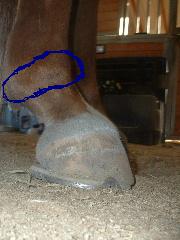  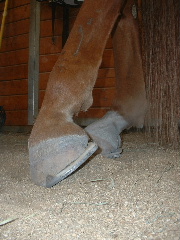 He has hard swelling, he's always had windpuffs, just larger now, very little heat if at all (varies day to day) if there is heat it is normally on the inside cannon just above the hard swelling. 3 weeks ago the inside annular ligament had heat as well, but has not had heat since then. Vet said he needed him to have more of a lameness in order to do blocks, but he would come out if I wanted and do a lameness exam and xrays. I think ultrasounds would be better, but I realize xrays should be first to do ruleouts but I'd like to jump to ultrasounds to save a little money. However, I don't believe the vet suspects suspensories. He is not painful upon palpation anywhere. He walks evenly, large stride, on the flat, a tad uncomfortable going up or down hills. I'm just not sure what to do and what avenue to explore or if I need to explore. Does this look like anything you've seen before? Would a horse with DSLD/ESPA present like this at the onset? Can windpuffs get worse? Could that be all this is? If so, should I sweat them? I want to take these shoes off and replace them with steel shoes with no pads. He's not weighting his heels which he has never done before behind. Sorry for the rambling... Thank you Dr. O. |
| Member: sunny66 |
Posted on Monday, Jun 29, 2009 - 4:58 pm: His iron level was 346 - 146 above the high normal - tested in May. I've eliminated every single thing that has even a little iron in it ever since I received the blood test results. He's getting retested the end of July.I've found balanced timothy hay cubes and I'll be working on switching him over which has: 90 ppm: zinc 30 ppm: copper 90 ppm: manganese .3 ppm: magnesium .8 ppm: iodine 1.8% fat 9% Protein These cubes are touted as perfectly balanced for calcium/phosporus, etc. and are suggested for easy keepers. According to this link: https://www.horseadvice.com/horse/messages/3/8826.html He still may be getting 30-300 ppm of iron from his orchard hay. He has received accupuncture/accupressure on a very regular basis, and over the past 5 months his liver has been an issue each time. This horse has never had soft tissue issues before this. He's also now borderline IR, glucose was fine but insulin was high not much, just a bit, will get the numbers for you tomorrow if you'd like. [quote][Excess iron cancels the absorption of copper and zinc- even if there is an “adequate” amount of those minerals available. Excess iron has many effects, including predisposition to infection, a predisposition to arthritis and increased risk of tendon/ligament problems, liver disease and altered glucose metabolism – including insulin resistance and overt diabetes. Eleanor Kellon, VMD][/quote] https://www.hoofrehab.com/diet.htm |
| Moderator: DrO |
Posted on Tuesday, Jun 30, 2009 - 7:13 am: Hello Aileen,If I understand your post you are concerned about a mild lameness that is not well characterized and the positioning of the pasterns: that they are becoming increasingly horizontal on weight bearing. The farrier says they are breaking down and the vet does not agree but seems rather vague about whether he can help. Aileen, I think I would consider getting a referral to someone who feels they can help you more. DSLD presents like your post early but that is not the same as saying this is what your horse has. Considering the images there is a general impression the hoof-pastern axis is broken but if that is do to the suspensories weakening in the back it may not require trimming changes. For more on this the article on DSLD has suggestions on trimming horses with weak suspensories. DrO |
| Member: sunny66 |
Posted on Tuesday, Jun 30, 2009 - 12:57 pm: Thank you Dr. O, I have looked into taking him to a vet that specializes in dsld/espa, just to rule it out; however, the cost is upward to $600 for just the exam.Will study your dsld article, get xrays and ultrasounds done first, then go from there. Thanks again. |
| Member: shanson |
Posted on Tuesday, Jun 30, 2009 - 1:46 pm: Sounds like you haven't had a basic lameness exam yet with blocks, etc.? And your vet doesn't think he's lame enough for exam?If it were me, rather than go straight to expensive specialist or ultrasounds, I'd follow the usual path of having a basic and systematic lameness exam with appropriate blocks to localize the issue. If needed, xrays and ultrasounds may follow based on results of exam. I guess I'd also be looking for a different vet to do this, as you seem to have some doubts about current one. Not saying change vets necessarily, but maybe a second opinion from another vet would be a good idea at this point? |
| Member: sunny66 |
Posted on Tuesday, Jun 30, 2009 - 5:46 pm: Hi Sharon, yes, that's what I will do, the vet will do the blocks if I request, he just said blocks are much more useful with a more pronounced lameness. He's had lameness exams/blocks done over the years, but something different always comes up. I trust him, and he is the first one to refer me out... he's done so already. This horse has seen at least 7 different vets, 5 different farriers, etc. over the last four years, along with chiro, accupuncture, massage, reiki. I've tried everything I could - he will be seeing two vets for the next appointments.Thank you. |
| Member: scooter |
Posted on Tuesday, Jun 30, 2009 - 8:49 pm: Hi Aileen, nice to hear from you. I have wondered how Brave has been doing . . If you think the shoes are making him worse, it can't hurt to try a different approach could it? Does he seem worse since this new shoeing package was applied? Like Dr.O. said his angles appear a little off, but maybe there is a reason for that. How did he manage to get laminitis in one hind? Good Luck with Brave I know it's been a battle 
|
| Member: kerrief |
Posted on Tuesday, Jun 30, 2009 - 11:18 pm: Aileen,You might want to check out the DSLD/ESPA Yahoo group. It's very informative. High iron could be a red flag for DSLD/ESPA. I too, have been battling a 4 year, off and on lameness, that is looking more and more like it is DSLD/ESPA. I'm currently waiting for the results of an iron test on my horse. |
| Moderator: DrO |
Posted on Wednesday, Jul 1, 2009 - 9:01 am: Kerrie, I must say I have never heard of high iron as being correlated with DSLD. It is important to understand there is little research so we do not well understand iron concentrations in the horse. The small amount of research done indicates that the levels in horses are quite variable depending on breed, dietary iron, and according to at least one report, have a diurnal variation. Also considering the pathophysiology of the ESPA form of DSLD it is hard to figure out how high iron could be much of a red flag. I would think at best it would suffer from low specificity and low sensitivity. Then again let's back up and try to nail this thing down as I have never seen proof this is not the case.Kerrie what level of iron (I presume in the serum) is thought to be a red flag? "Serum iron" is a bit of a confusing term as it is found in two forms in the blood. Are we talking just the iron (not really free iron but is bound to transferrin) or are we including the ferritin (that bound to apoferritin) component too? I am glad you brought this back up as I had meant to address Aileen's reference to iron. Aileen I will presume the units of your iron lever is micrograms/dl. The level you list falls within the normal values found in this study at least for some breeds: Tierarztl Prax. 1988;16(2):163-5. [Iron and iron-binding capacity in the serum of clinically healthy horses][Article in German] Schorr G. I. Medizinische Tierklinik der Ludwig-Maximilians-Universität München. Serum iron concentration and iron-binding capacity were determined in 34 respectively 35 clinically healthy horses of different sex, with the age of 3 to 21 years. In the Warm blooded horse, the Half bred, the Haflinger horse, the Heavy horse and the Arabian Haflinger the mean serum iron concentration amounted to 253 +/- 66 micrograms/dl, 202 +/- 87 micrograms/dl, 166 +/- 67 micrograms/dl, 183 micrograms/dl and 366 micrograms/dl, while the iron-binding capacity in the Warm blooded horse, the Half bred, the Haflinger horse, the Thoroughbred, the Heavy horse and the Arabian Haflinger ran up to 427 +/- 55 micrograms/dl, 530 +/- 162 micrograms/dl, 422 +/- 63 micrograms/dl, 447 micrograms/dl, 467 micrograms/dl and 394 micrograms/dl. Regarding serum iron concentration no age or sex differences were ascertained, whereas they were obvious when observing the iron-binding capacity. Diurnal variations in serum iron concentration are pointed out. The quotient of the two examined parameters showed race-related differences. The results are presented in tables. Surprisingly I cannot find any other published studies on iron levels in healthy adult horses but they suggest that if the lab does not correct their normals for the breed of horse there may be incorrect normals generated. Either that of the degree of variation is very large in all horses. DrO |
| Member: shanson |
Posted on Wednesday, Jul 1, 2009 - 9:20 am: Oh my! I didn't realize this was such a long (and likely expensive) ordeal. Maybe I'm speaking out of turn here...if so, please accept my apology.Having been in your position a few too many times, I know how hard it can be to determine when enough is enough...measured in $, time, and emotional investment. It's easy to lose perspective once you start down the path of diagnosing elusive lameness issues. I've learned that some horses just have issues that can't be resolved, no matter how much time & $ you spend. With luck, the horse is serviceably sound much of the time with correct management. You ride him when he's sound & give him time off when he's sore. In less-lucky cases, you have a pasture ornament. So I guess what I'm saying is that, at some point, it's healthy to step back and evaluate whether you've reached the "enough-is-enough" point. It can be a real relief to let go and accept the horse's (and/or your wallet's) limitations. Again, my apologies if I'm out of line here... |
| Member: sunny66 |
Posted on Wednesday, Jul 1, 2009 - 10:32 am: No problem Sharon Thank you. Thank you. Diane, thanks  I don't have a lot of time to respond, will respond more indepth later. Kerrie, I have been corresponding with Dr. Kellon, and she's been a huge help. I plan on getting the ferritin and transferrin tests done at the end of July if his iron is not down. Dr. O, the iron test states Serum Iron Result 346 Reference Range: 50-198 ug/dL This was flagged as very high. |
| Member: kerrief |
Posted on Wednesday, Jul 1, 2009 - 3:13 pm: (Cut and paste from DSLD/ESPA website)IRON BLOOD TESTING- *Having blood drawn on your horse and testing for iron & ferritin will show where you dsld horse tests for overload on iron. Many dsld horses are showing high iron levels and some low in magnesium. Send blood sample to University of Kansas as they are testing for ferritin levels and Dr Kellon is doing a study on ferritin levels in dsld and non dsld horses. Information and forms found on Vet pages linked on home page. |
| Member: sunny66 |
Posted on Wednesday, Jul 1, 2009 - 3:51 pm: Kerrie, I'm also going to test for copper and zinc, as well as iron, on the next go around, just to see. I'm going to ask for a separate vial to send to Kansas U, I've decided to send it regardless if his iron is down, just to see. fyi, he has a magnesium level of 2 with 1.9 being the normal high.Sharon, I do appreciate your thoughts. At this point I'll be happy to keep him comfortable, but happier if I can ride him at a walk to help get his weight down. Diane, I don't think the shoes have made him worse, he is better than before the shoes were on. The problem I see now (in addition to the pastern DrOpping when weighted) is he's not weighting his heels behind. With everything we've been through this has never been a problem with the hind feet. I did find when he did not weight his heels with the front feet that he didn't like the packing, so I'm going to try that with the hinds. I have NO idea why he got laminitis behind and not in front. A mystery for sure. The vet's farrier put these shoes on him, they looked very balanced, I think his pasterns are giving an illusion of unbalanced. Thank you Dr. O for that study, would it also apply to ug/dL levels? I am hoping, that with the addition of copper and zinc to balance out the high iron, his issues will stabilize. We'll see. |
| Member: scooter |
Posted on Wednesday, Jul 1, 2009 - 4:02 pm: Can Iron levels vary day to day...month to month on horses?I was thinking about this thread as I was driving around and remembered last year I was having a few "problems" with tiredness and weakness so went to the Dr. They tested my iron in his office and it came back pretty low, so he sent me to the hospital where the tests are more accurate...it was even lower! Doc told me to take iron pills and come back in a month for re-test. I was a bad patient any only took them for about a week, because I kept forgetting to take them. Next month I went to the Dr. he ran an in office blood test, came back and did it 2 more times. After the test he walked in and said well you are quite a puzzle, now you're iron is in the high range and that isn't possible...he asked if I was taking my pills...I lied and said yes  He said regardless it is impossible for iron to recover that fast HMMMM so he sent me to the hospital to have the more accurate test again He said regardless it is impossible for iron to recover that fast HMMMM so he sent me to the hospital to have the more accurate test again . It also came back high, so I had to have ultra sounds and x-rays ect. they thought maybe I had something wrong with me. Dr.once again said it wasn't possible...but the proof was in the pudding as they say . It also came back high, so I had to have ultra sounds and x-rays ect. they thought maybe I had something wrong with me. Dr.once again said it wasn't possible...but the proof was in the pudding as they say Maybe you should re-test his iron levels again...just to make sure. |
| Member: vickiann |
Posted on Wednesday, Jul 1, 2009 - 7:08 pm: My daughter had a problem with high iron when she was in high school and drinking huge quantities daily of orange juice, high in folic acid.Too much of one thing can cause an imbalance in something else. The problem was not that she was taking in too much iron but rather that she was retaining too much. The doctors told her to cut red meat intake, but it was the high folic acid intake that was actually the problem. This caused hair loss and other problems |
| Member: kerrief |
Posted on Wednesday, Jul 1, 2009 - 10:26 pm: Aileen,That's interesting about your horse and high magnesium. My horse has high magnesium too; and (just got iron in) normal high iron. I'm having hay analyzed. She does not get any supplement with iron or magnesium in it. SHe eats 4 pounds timothy/1 pound alfalfa 3 times daily. Vet rec no alfalfa for the time being. I agree, do check zinc and copper levels. That's my next test also. |
| Moderator: DrO |
Posted on Thursday, Jul 2, 2009 - 7:58 am: Aileen ug is a abbreviation for micrograms so is the same units as in the above German study that found in some healthy horses levels are higher than what your lab found in your horse. And your labs normal values are well below that found in this study. I always tell folks that they should use their lab normals for interpretation but when I see a normal that is well below the low levels found in a peer reviewed published survey as that conducted above, I wonder what can be going on and it raises two specific questions: how did your lab develop these normals and how accurate is their testing.Kerrie, an interesting statement that I find no support for in any of the scientific literature. Combine that with the little known about normal iron levels in the blood (see above discussion) I wonder what is the basis for the statement? And even if true what is the significance of the finding? It is my time to beg an early apology and stick it out here with the hope of getting through with blunt speech where specific scientific evidence has failed. I again find members discussing expensive tests for specific mineral levels whose meanings are poorly understood and not well related to the condition being discussed. Since the information is of unknown value I consider it a waste of time, a waste of money, and perhaps worse leads to questionable treatments. If you are concerned about minerals in your horses diet, read the article on minerals it gives specific information. If you have to spend money on this subject you are better off testing the nutritional content of your hay or pasture than your horse. In short there is a lot of wheel spinning going on above that is not helping to get the problem solved. DrO |
| Member: kerrief |
Posted on Thursday, Jul 2, 2009 - 9:54 am: I agree Dr.O, there is alot of wheel spinning going on. It's extremely frustrating when you have a long term on going lameness that cannot be completely explained, and does not respond to treatment. The comments made about iron and magnesium are from Dr.Kellon's DSLD/ESPA group; and also on various websites. As you are aware, she has been doing research on DSLD and these are trends she is seeing. Not all DSLD horses have high iron and or low magnesium; but there are enough that do that it is worth taking note of. |
| Member: juliem |
Posted on Thursday, Jul 2, 2009 - 10:23 am: I think Dr. O's point is missed. I believe he's referring to research studies that are well constructed (double blind, controls, etc.) well conducted, published and peer reviewed. As you know, just because something is discussed on a website doesn't give it any special credibility. Mars appearing as big as the moon in August has been discussed on MANY websites! Dr. O has to be our horsey version of snopes.com! |
| Member: sunny66 |
Posted on Thursday, Jul 2, 2009 - 10:34 am: Dr. O, keep it up I do need a reality check at times I do need a reality check at times  But you have to admit, four years, oh my, FIVE years now my sweet horse has had issues with pain. It's all on this board. No one can pin point exactly what it is. We fix one thing and another thing pops up. First hock arthritis, then ringbone, then navicular, then heart murmur, then stifle arthritis, then ligaments,and throughout it all he is fat. Feeding him like a pony doesn't work, feeding him like a horse doesn't work, chromium doesn't work, magnesium doesn't work. His thyroid is fine, but vet wants to try thyroid meds just long enough to get weight off. But you have to admit, four years, oh my, FIVE years now my sweet horse has had issues with pain. It's all on this board. No one can pin point exactly what it is. We fix one thing and another thing pops up. First hock arthritis, then ringbone, then navicular, then heart murmur, then stifle arthritis, then ligaments,and throughout it all he is fat. Feeding him like a pony doesn't work, feeding him like a horse doesn't work, chromium doesn't work, magnesium doesn't work. His thyroid is fine, but vet wants to try thyroid meds just long enough to get weight off. I DO know that his weight is most likely the cause of all of this, if I can get him sound enough to maintain a working (walk only) regimen I could get the weight off, but I can't even keep him sound at the walk for longer than 2 months at a time. I am in a vicious circle that is neverending. So yes, researching what I can even though it's not proven, I'm trying different things to see if they will help my horse as long as these things won't hurt him... that's where you come in  With regard to testing hay, that's why he's on those hay cubes, they are balanced minerally so I don't have to worry about testing his hay. Look at it this way, maybe this will help and you are helping us by making sure we keep our heads on straight while making these decisions. You are invaluable. Thank you. |
| Member: sunny66 |
Posted on Thursday, Jul 2, 2009 - 10:36 am: One more thing, I believe Dr. K has researched silica in the hopes that it may help with connective tissue, I think she believes it will not, Dr.O do you have any research to the contrary? |
| Member: scooter |
Posted on Thursday, Jul 2, 2009 - 3:31 pm: Aileen, I was going to ask you how his weight was, I know you battle the bulge like I do. My mare has DrOpped fetlocks and if I get weight off her they become much more normal looking. Horses ailments seem to get way worse when they are fat or even produce ailments in it's own right I had a very hard time putting my horses on quite a restricted diet as you know, but the good it did them, it was well worth it, it is a constant battle that I get VERY sick of, but the reward is great. Put Brave on a "weight watchers" diet I bet you would be surprised how much better he will feel all around  It took awhile to get it through my head, but I thought I was starving my horses too. Obviously I wasn't! My vet is a fat freak, and he said to give them one flake of hay morning and night, when I finally brought myself to do that the weight started coming off. MY easy keepers need only 1% or LESS of their BWT to loose weight. They adjusted, I adjusted, and a good part of their ailments went away, or got much better. They are far from thin, but normal anyway, and Hank can now be exercised since he isn't lame all the time It took awhile to get it through my head, but I thought I was starving my horses too. Obviously I wasn't! My vet is a fat freak, and he said to give them one flake of hay morning and night, when I finally brought myself to do that the weight started coming off. MY easy keepers need only 1% or LESS of their BWT to loose weight. They adjusted, I adjusted, and a good part of their ailments went away, or got much better. They are far from thin, but normal anyway, and Hank can now be exercised since he isn't lame all the time With their meager portions they stayed slick and shiny(exept hairy Sam) and had PLENTY of energy, so I don't think it hurt them any nutrition wise  I am not saying fat is Brave's problem, just that it can definitely make things way worse then they really are. We can help you if you need it  Taking weekly pics and weighing Hank and putting them on here kept me honest! And the support was great! Taking weekly pics and weighing Hank and putting them on here kept me honest! And the support was great!
|
| Member: sunny66 |
Posted on Thursday, Jul 2, 2009 - 3:39 pm: Diane, he'll be retested I too would be curious if iron level fluctuate from day to day. I hope you're feeling ok now! I too would be curious if iron level fluctuate from day to day. I hope you're feeling ok now! Vicki, this: "Too much of one thing can cause an imbalance in something else." is what I'm afraid of, hence the copper and zinc. Thank you. Kerrie, even though our horses don't necessarily have similar issues (mine would literally blow up if I gave him that much hay... lol) would you mind keeping me posted on what your results are for the copper and zinc? You could email if you'd rather: adalen@m-w-h.com |
| Member: sunny66 |
Posted on Thursday, Jul 2, 2009 - 3:55 pm: Oh Diane I just saw your latest post... Even on 8 pounds of hay per DAY - entire portion of his hay - he doesn't lose weight. He's 15.3, big barreled and even the vet said I couldn't feed him less than that... However, with these new hay cubes that have only 1.8% fat, I'm hopeful that finally I have found something that may work. He has already lost 20 pounds with the hay cubes being just half of his 8 pounds of feed I just saw your latest post... Even on 8 pounds of hay per DAY - entire portion of his hay - he doesn't lose weight. He's 15.3, big barreled and even the vet said I couldn't feed him less than that... However, with these new hay cubes that have only 1.8% fat, I'm hopeful that finally I have found something that may work. He has already lost 20 pounds with the hay cubes being just half of his 8 pounds of feed  He did look a little better this morning - more upright - but it was dark, I'll check him again tonight. |
| Moderator: DrO |
Posted on Thursday, Jul 2, 2009 - 10:00 pm: Aileen, in the article I reference above we discuss the latest information on silicon in the horses diet.DrO |
| Member: sunny66 |
Posted on Friday, Jul 3, 2009 - 12:41 am: Thank you Dr. O, I found it on the mineral page I did read this on your suspensory page: [quote]Traditionally it has been recommended that support with slightly extended heels in the form of an egg bar shoe or even elevated heels might help however with careful studies both of these actually increase the strain on the suspensory. Achieving a good straight hoof pastern axis (a-p balance) and a moved-back breakover in the form of rockered and rolled toes to decrease strain on the support structures during movement are probably the best recommendations[quote] I talked to my farrier last night about taking his shoes off and putting "normal" shoes on with good heel support, but not enough to compromise his leg. She's asked me to call my vet and she'll do as he says. I feel the shoes he has on now are hindering his hind end. Do the extensions look excessive to you? I took closer pictures tonight because I thought he looked better. On closer inspection, his left hind inside tendons (never have palpated sore but a bit swollen) look better but not the fetlocks, however, he does appear to be a bit more upright: Left hind 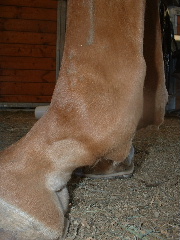 Right hind 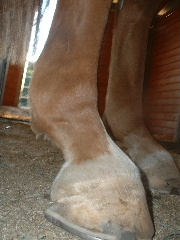 These aren't very good pictures, sorry. Can you tell he has hair loss at the side/behind the pastern? I wonder why? I don't see any abrasions ... anything... |
| Moderator: DrO |
Posted on Friday, Jul 3, 2009 - 6:59 am: No not extensive, Aileen. I don't know about the hair either but it looks rubbed away.DrO |
| Member: sunny66 |
Posted on Friday, Jul 3, 2009 - 10:58 am: Thank you Dr. O!Hypothetical question for you? If you had been treating a horse for a long time, and you know he's had the windpuffs since he was 6 years old (currently 16 years old), you see the windpuffs harden - you tell the owner to cold hose and bute/equioxx for 10 days and they get better. A few months later you come across the current scenario in this post... when you first see the horse you palpate thoroughly with no response, take the hooftesters and get a response along with increased digital pulse (moreso of each with the left hind). You request laminitic pads put on. The windpuffs had not changed significantly when you saw the horse this time. Owner calls and tells you a month later that the windpuffs are increased in size and were hard for 2-3 weeks. Currently they are softer but lumpier. Owner feels the horse is stiff but it is coming from the stifle/hindquarter area (physical therapists think ligament strain in the stifle/illio area and suggested stall rest for 6 days with MUCH improvement), not so much the fetlock... even though visual observation when the horse is standing owner thinks the stiffness should be coming from the fetlock. Would you suggest an immediate visit when the lameness is not readily apparent? Would you suggest to bute the horse for 5 days and keep the appointment at the end of the month dependent upon improved status? (He has improved with equioxx). End of hypothetical... lol My feeling is that the shoes are the problem for the stifle hindquarter area. When first put on the extensions were 1/2" to 3/4" past the heel buttress. I want to change the shoes and see if the stiffness improves, if not return to the pads and extensions in four weeks. I am under no illusions that I can escape retirement for this perfect horse ...unfortunately... but I do want him as comfortable as possible. |
| Member: sunny66 |
Posted on Friday, Jul 3, 2009 - 5:45 pm: I finally reached my vet, I told him:I felt he was standing more upright, his fetlocks are lumpy and soft, I can hear his heart murmur again (it was always there, but there was a quite a few months when the vet could hear it and I could not), he's on equioxx, walking evenly and long strided, and his sense of humor is still good I also asked about changing the shoes, he felt I could try. He will be out two weeks after the "normal" shoes are put on and evaluate/xrays. I'm to call if he worsens in any way and he'll come out sooner. Thanks all! |
| Member: scooter |
Posted on Friday, Jul 3, 2009 - 7:56 pm: Good Luck Aileen, hope Brave continues to improve
|
| Moderator: DrO |
Posted on Friday, Jul 3, 2009 - 9:48 pm: Aileen, I really cannot make heads or tails of your hypothetical, my treatment would be based partially on the history, but mostly on my physical exam. As to when the horse needs to be seen that really depends on your evaluation of the situation (is this an emergency?), your goals, and your resources.DrO |
| Member: sunny66 |
Posted on Monday, Jul 27, 2009 - 10:46 am: Vet came on Saturday. Put him on the lunge to the left, ow ow ow, but not dead lame. Told the vet he'd be worse to the right - with the extensions on he would not even trot to the right and I hadn't checked him since the new shoes were put on without extensions - he moved better to the right!!!!!Vet ok'd my friend (weighs 100 pounds soaking wet)to ride him at a walk every other day for 20 minutes. I had her hop on him while he was doing another horse in the barn so he could see and said Brave looks great  Once I get 100 pounds off him then I can ride him at a walk since I weigh 56 pounds more and I ... ahem... won't ride him bareback so he'll also have the weight of the saddle. Once I get 100 pounds off him then I can ride him at a walk since I weigh 56 pounds more and I ... ahem... won't ride him bareback so he'll also have the weight of the saddle. He took blood to recheck his iron and insulin levels, if his insulin is still higher than normal then he'll go on thyroid meds. I asked him if we could check his thyroid and he said to do it correctly would mean taking his blood something like 6 times a day - otherwise it wouldn't be correct. He agreed with the theory that the extra weight may be causing the fetlocks to look that way and for the pasterns to dip (thanks Diane!). We're hoping that's the cause, so we'll see what happens. Currently they look quite good, sorry no pictures, but vet said because of the strain the synovial fluid building up, so that's what I'm seeing. So now I'm hopeful again to at least be able to ride him at a walk to help keep his weight down. Oh and I can't remember if I asked here or not, but I had him look at his eyes, no jaundice but he could see why I would think that. Also his pulse was very strong and even, so he thinks his heart is ok as well. Thanks all! |
| Member: scooter |
Posted on Monday, Jul 27, 2009 - 10:36 pm: Good news Aileen I hope Brave continues to improve. Keep us updated! I hope Brave continues to improve. Keep us updated!
|
| Member: paardex |
Posted on Tuesday, Jul 28, 2009 - 11:26 am: Aileen I never heard a better reason to loose weight! If you market Brave a 'weightloser' you'll get rich. [and slim I guess ] You do however give me a good reason to loose weight, bet it will be better for a swayed back horse to. ] You do however give me a good reason to loose weight, bet it will be better for a swayed back horse to. Doesn't a light english saddle help? I wouldn't like bareback either! Jos |
| Member: shanson |
Posted on Tuesday, Jul 28, 2009 - 1:11 pm: So, he's lame to the left, but OK to ride? |
| Member: sunny66 |
Posted on Tuesday, Jul 28, 2009 - 3:27 pm: Thanks Diane His iron is at 256 - normal 198 - but BETTER than 346 which he was two months ago His iron is at 256 - normal 198 - but BETTER than 346 which he was two months ago  Haven't spoken with the vet yet, the office just called to let me know. Hopefully it's because it takes a while to get the iron out of his system... ihopeihopeihope... Haven't spoken with the vet yet, the office just called to let me know. Hopefully it's because it takes a while to get the iron out of his system... ihopeihopeihope... LOL Jos, I agree, I've been trying so hard, but I haven't been able to go below 156 for three months now  It would be his dressage saddle I'd be using. I think we're being sufficiently cautious, which is just fine with me. It would be his dressage saddle I'd be using. I think we're being sufficiently cautious, which is just fine with me. His insulin will be back most likely the beginning of next week, then we'll see about thyroid meds. Hi Sharon, thank you, I should clarify, he'll be ridden at just a walk - at which he is completely sound - around the perimeter of my arena only for 20 minutes every other day. Vet said he feels that with all the hind end business going on his patella may be getting slippery and that exercise would be the best thing for him right now. |
| Moderator: DrO |
Posted on Tuesday, Jul 28, 2009 - 9:53 pm: Aileen, as I posted above the normal levels of iron found in horses blood in the largest study I can find on the subject found the level from 166 to 366 ug/dl.DrO |
| Member: sunny66 |
Posted on Monday, Aug 3, 2009 - 10:21 am: Thank you Dr. O, I guess I don't know why the vet was concerned if this is the case. Perhaps because I was very concerned. Regardless, it's down now after diet changes and I'm happy about that His insulin is back to normal, I don't have the numbers yet. But he will not go on thyroid meds because of this. I was thinking of what I could try that wouldn't hurt him. I decided to try some B-12. He's down from 1230 to 1219 after one day of the B-12. Could definately be a combination of the walk work and the B-12. But I weighed him before I gave it (1230) and weighed him the day after (1219)... We'll see what happens. |
| Member: sunny66 |
Posted on Saturday, Aug 15, 2009 - 8:11 am: Hi Dr. O and all,fyi He's wavering between 1187 and 1203 on the weight tape I have more pictures... one very scary one - I realize it's fully weighted, but still ...left hind 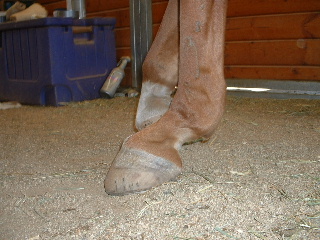 These don't look half bad to me, he's due to be trimmed next Sunday.. which he needs badly. 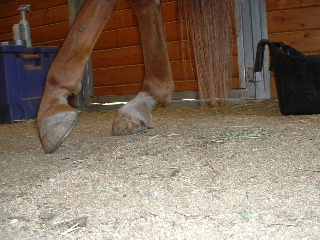 Left hind looks much better here 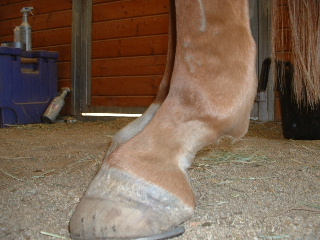 Here's a left hind from before for comparison 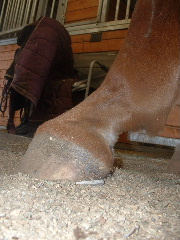 Right hind 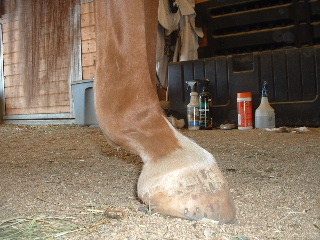 Do you see any improvement? I see a bit more straightening when he's standing square. He's not digging in his toes anymore. Before I saw the scary one above I thought I was on the right track, but now I'm not so sure. |
| Member: sunny66 |
Posted on Saturday, Aug 15, 2009 - 8:15 am: Oh and I talked with the vet and received the actual numbers for his insulin/glucose:Insulin: 23 (ratio: 29-179) Glucose: 4.1 (ratio 4.2-6.4) So now he's low! I understand that since I've taken out almost all fat from his diet and eliminated all carbs this is most likely normal, but any other suggestions on his diet are appreciated. |
| Member: scooter |
Posted on Saturday, Aug 15, 2009 - 9:53 am: Hi Aileen, I don't know what to say about the DrOpping fetlocks...he does look a lot like my mare.What's his turn out like? Is he moving around ok. Seems like when my mare's fetlocks started DrOpping she would switch weight quite often from one leg to another, she also had filling (windpuffs?) like Brave does.....I know Dr.O. probably won't agree with this but at that time legend IM seemed to make her very comfortable, I guess it does have a bit of an anti-inflammatory effect to it. I gave it to her for about a year. Getting the weight off to where I could see her ribs slightly too helped immensly. They are still DrOpped, but seem to have stabalized for the most part and she is comfortable. I don't ride her anymore tho...not because of her fetlocks. FME Insulin and glucose can VARY greatly. My fat pigs are IR and theirs always tests normal...with glucose being a little low...think it has something to do with how long the sample sits around before being tested. If he is IR his appearance should pretty much tell you. If it quacks like a duck it usually is! Can you post a full body pic of him? |
| Member: erika |
Posted on Saturday, Aug 15, 2009 - 10:30 am: Aileen, I see that you are already on the Yahoo group for DSLD. There is a group for Cushings/IR horses too that addresses iron issues if that is still a concern. Since it sounds like that might also be an issue for Brave, you might want to check it out.Erika |
| Member: sunny66 |
Posted on Saturday, Aug 15, 2009 - 11:58 am: Thank you Erika, I'm on that site too... my vet said it will take a while for the iron but it has already gone down quite a bit I've already changed his diet to almost all of Dr. Kellon's recommendations, aside from how much to feed and the flax. Since he blows up on flax I wanted to see what I could do without it first. I've already changed his diet to almost all of Dr. Kellon's recommendations, aside from how much to feed and the flax. Since he blows up on flax I wanted to see what I could do without it first. Hi Diane, yes, I know... it seems to be all about the weight! Here he is in June: 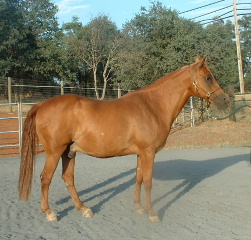 Today, I had no one to help me so this is the best I could do: 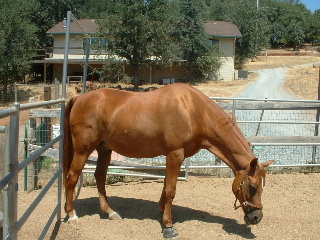 And the hind view... note the lack of belly poking out... lol 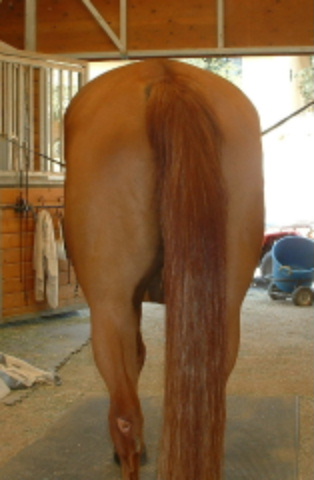
|
| Member: sunny66 |
Posted on Saturday, Aug 15, 2009 - 12:05 pm: Forgot to answer turnout questions. He moves around at the walk just fine... he will trot but would rather not. He has his stall and 24/16 run and 50 x 70 paddock 24/7. He has a 3/4 acre "pasture" (now dead) for 12 hours a day to walk around in.I lunged him last weekend just to see. He was nqr at the trot and canter... all in his hind end at the canter (hoppy), couldn't tell where at the trot. Not headbobbing or anything. This is a cropped picture of his left hind (me riding him at the trot) March of 2008. 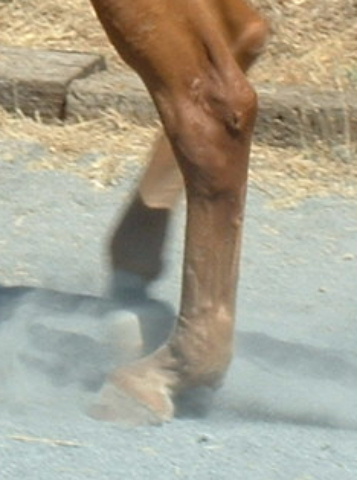 It looks the same as his fetlocks look today to me, but his pasterns are better. So that means one of two things I think: 1) this is normal for him; or 2) it's been his issue all along and no one saw it. Thoughts? |
| Member: vickiann |
Posted on Saturday, Aug 15, 2009 - 3:18 pm: Aileen -- Hard to tell from the photos but in the recent ones it appears that the shoes are not extending as far beyond the heels as in prior shoeings.Shoes that extend beyond the heel is a big no - no with my farrier as he explains placing the shoe beyond the end of the heel only places more pressure on it and ultimately seems to result in crushed heels. I have found this to be true in my experience. You WANT your horse to land heel first if he is going right rather than toe first. |
| Member: mrose |
Posted on Saturday, Aug 15, 2009 - 3:58 pm: Vicki, it really depends on what you are trying to do with the hoof as to whether or not the shoe extends past the heel. A lot of times a little extension is added to give support to the heel and encourage heel growth as I understand it.Aileen, it's hard to tell from the above picture, but if that was taken of the horse at a trot, depending on where he is in his stride, I don't think it looks that abnormal. Most horses with a longer fetlock, DrOp the fetlock as a normal part of their movement. In your pictures posted on Aug.15 at 8 a.m.(approx.) his feet look stubby toed to me. Is this normal for him? The top one of the left hind does look "scary" but I would love to see him in motion. Sometimes when a horse relaxes they will stand for a while with a fetlock DrOpped. Could he have been doing this when you took the picture, or is he always standing DrOpped like this? |
| Member: sunny66 |
Posted on Saturday, Aug 15, 2009 - 9:02 pm: Thank you Vicki, yes, I agree. He is doing much better with the form of his hind hooves without the extensions. You can see how much his heel has grown since taking off the extensions. I do think he needed the extensions at the time, I'm hoping he doesn't still need them.Sara, boy I hope that's the case! That he's just relaxed into that stance! I have some video with my tiny friend riding him, but I don't want to post those without her permission. I'll put him on the lunge tomorrow and see what I can come up with. |
| Member: sunny66 |
Posted on Sunday, Aug 16, 2009 - 6:13 am: Here is a short clip from March 2007, note at the very beginning his fetlocks DrOpping at the trot... and he's sound:https://s141.photobucket.com/albums/r59/wishes_album/?action=view¤t=DSCF008 4.flv I saw him actually trot in good form this morning!! No headbobbing, granted he was spooked, but for the last couple of months, even when spooked, he would just walk faster. Perhaps this is just a patience lesson, I hope. But more comments are more than welcome. I'll try to get a short clip up of him later this morning. |
| Member: sunny66 |
Posted on Sunday, Aug 16, 2009 - 8:05 am: Ok, more short clips:Trot: https://s141.photobucket.com/albums/r59/wishes_album/?action=view¤t=DSCF000 4-1.flv Trot/Buck/Canter/Trot: https://s141.photobucket.com/albums/r59/wishes_album/?action=view¤t=DSCF000 5-2.flv Walk: https://s141.photobucket.com/albums/r59/wishes_album/?action=view¤t=DSCF000 8.flv Sorry for the short jerky clips, you can see he had a bit of energy this morning, I didn't post the most athletic ones... lol ... in those his ears are up and he looks fabulous, but you can't really tell anything from them. The ones I posted his ears are mostly back, telling me hind end and I'm seeing him almost hip walking. |
| Member: scooter |
Posted on Sunday, Aug 16, 2009 - 11:58 am: Aileen I'll throw this out at you In your first post in this thread you said he foundered in the rear or had laminitis in May? In your first post in this thread you said he foundered in the rear or had laminitis in May? When Hank foundered in the rear he had swelling like Braves and his fetlock appeared DrOpped. I commented about it in one of my many posts about his founder. I don't know what about founder would cause this except maybe the extra pull on the ddft. The reason I bring this up is in your videos...which are kind of short to tell for sure...he moves just like Hank did after his founder in the rear, I also had a mare years ago founder in the rears and her fetlocks about DrOpped to the ground. I was concerned about DSLD with her, but once we put a regular egg bar on her and got he out of the chronic state of laminitis her fetlocks went back to normal same with Hank....took about a year in each case, but saw an improvement monthly. I have no idea how founder can make the fetlock DrOp as was my experience and only in the rears. Have you had Brave hoof tested lately...his hooves could still be sore if he just had a bout of laminitis in May. Thought I'd throw that out there 
|
| Member: vickiann |
Posted on Sunday, Aug 16, 2009 - 12:11 pm: Aileen,Has he stopped raising his heels up off of the ground as earlier described? That was something that my daughter's horse, Fancy did when she was in jumping shoes. Does your horse have any pain in the lower/hip portion of the back? When we saw the specialist Veterinarians about Fancy's problem, sacroiliac issues were described as sometimes being the problem with long term unanswered issues such as you describe and when the true source of the problem, injecting the sacroiliac joint was described as a miraculous cure. Fancy had a dorsal sacral ligament tear that was causing her to go poorly, plus unbalanced feet that may have contributed to her becoming injured. but not a sacroiliac problem. X-rays also showed a very flat palmar angle in her right rear, which has now corrected, as has tendency to take the weight off her rear heels since her feet have been properly balanced and remodeled to normal after a few months out of the shoes. Good luck figuring this out. It is so frustrating when these things drag on. |
| Member: sunny66 |
Posted on Sunday, Aug 16, 2009 - 12:46 pm: Thank you ladies! I apologize for the lack of quality and length in the videos. My camera just does 20 second videos.I think his canter has improved 10 fold. Before, while his front end would canter normally, he would hop straight up and down behind, so he would not get anywhere. I hadn't seen him trot or canter for what seems like months. Last week, it was better, I got a canter (both hind and front) but it was still hoppy. This week I saw barely any hopping - just defiance... lol. Diane, last time he had absolutely no reaction to hoof testers; however, he was buted... and will be again the next time. So I'm not certain how I will tell. It would be very interesting to find out what Dr. O thinks about the correlation of DrOpped fetlocks and rear laminitis! I also have to wonder since his insulin is so low, he's not getting any carbs, if that is helping as well. Vicki, he does not raise his heels any longer, while he does drag his toes a bit, you can see his hind feet hitting the sand up in the videos. I can see him hip walking at the walk only. I can't see it at trot or canter. He has had low lumbar pain, plus ligaments in both hinds (around the stifle and the illio) have been strained. Vet did not locate these, this was through a body worker. She worked on them then he was stall rested for 6 days and he was much better. I was wondering if he needs more rest, but he keeps improving. Oh and Sara, I forgot to answer your question about his squared toes. They are that way on purpose, to ease his breakover. That is critical for him right now in easing stress on tendons, ligaments and joints. I can't wait to see what he does when he's shod next week - if he's worse or better. That may be a very valid point. |
| Member: scooter |
Posted on Sunday, Aug 16, 2009 - 1:03 pm: Aileen why is he buted, for shoeing? I wouldn't think it would hurt to take him off bute a couple days to see if he reacts to the shoeing or hoof testers it could tell you a lot.When Hank foundered I always tried to make sure he was bute free during his trim or shoeing so I could see his reaction to pounding and how he walked off when done....with bute I couldn't be sure. Hank usually wouodn't hoof test sore when on bute. Off it his reaction was quite different. At least it would give you a process of elimination starting with his hooves. |
| Member: sunny66 |
Posted on Sunday, Aug 16, 2009 - 1:34 pm: Hi Diane,Farrier couldn't take his extensions off to be reshod. Had to reschedule when I could be there. Even on two grams of bute I had to hand twitch him on his nose and pretty much yell in his ear that he was a good brave boy and that it would be over soon in order get his attention off what the farrier was doing and to keep him from kicking out. However, once the extensions were off I did not have to nose twitch him, he stood very politely. I can't try without bute right now because I want to keep my farrier... lol Come to think of it, Vicki, when being reshod with "normal" shoes his back was spasming just in front of the hip! I was not twitching him then and he just dealt with it on a long lead. He is not on pain meds on an ongoing basis. I don't want him to exacerbate anything if ligaments are still an issue. He needs to feel that he's not invincable :::wink::: What I will do is ask the farrier to come by before being shod to hooftest him. Hopefully she'll have time. Thanks Diane 
|
| Member: vickiann |
Posted on Sunday, Aug 16, 2009 - 1:36 pm: My gray Arab, Lance, used to drag his toes back in the days of hoof problems when we used trimming or shoeing techniques designed to take the strain off the ligament and to prevent over-reach.He had strained a ligament and also got the wind puff afterward. The wind puff still comes and goes as well as a tendency to stock up a bit in the fetlocks if he stands around. All of his ways of going problems are fixed now though -- for about the past three to four years since he is in no shoes and has a trim that provides good balance laterally and medially. Riding him now is as smooth as can be, like flying. He was diagnosed with DJD a few years ago and I keep him on monthly Adequan but he goes just great. |
| Moderator: DrO |
Posted on Sunday, Aug 16, 2009 - 3:03 pm: Diane is right about my disagreement, there is no scientific work to show IM Adequan being able to create a noticeable improvement in arthritis joint pain and there have been quite a few studies. Usually some statistical improvment is seen but we are talking improvements of fractions of grade of lameness that in some studies were not signinificant. These are covered in the article on Adequan. For our recommendations on the treatment of arthritis check out Arthritis Overview.I have not seen a relation between degenerating suspensories and founder. If there is unexplained lameness best is a thorough lameness examination who's first step is to localize the lameness explained in Lameness Localization. DrO |
| Member: sunny66 |
Posted on Sunday, Aug 16, 2009 - 5:11 pm: Thank you Dr. O, vet thinks it may be his stifle so I'll go with his recommendation for walk work for a while and see if it helps.Vet doesn't recommend traveling for him due to the stress it causes him (heart/ulcers), he'd need to go to the clinic for a full workup...since he's retired I'll just let him be. I was just hoping. |
| Member: scooter |
Posted on Sunday, Aug 16, 2009 - 5:40 pm: DrO. I was reading about DSLD and found something. I wonder if you could comment on this. I just found it curious and wondered if there was a way of getting rid of this "parasite?The article https://www.friendsoftheperuvianhorse.com/research/researching.htm The excerpt about the parasite 6) Biopsies Why should researchers do biopsies for leg problems? Because that’s the only way of finding Onchocerca Reticulata, one form of the Nuchal Ligament parasite. These are microscopic parasites that migrate to the tendons and suspensory ligaments. They are very common throughout the United States and are spread by gnats or black flies. In a study by RM Corwin and Julie Nahm, of the University of Missouri College of Veterinary Medicine, states that these microfilariae are transferred through connective tissue to suspensory ligaments and tendons causing nodule formation and lameness and can only be found with a biopsy. What does Merial.com say about Onchocerca Reticulata? “Adult worms in ligaments and tendons can cause swelling. Microfilariae may infiltrate and irritate the cornea and iris of the eye, sometimes causing blindness. In heavy infections, adult worms can cause lameness, swelling in ligaments, and eye irritation.” Victor Alexander, DVM says, “This parasite can work in conjunction with other problems and the accumulation may be the very thing that pushes the horse to break down.” Dr. Alexander goes on to say, “Without a biopsy, the parasite remains unidentified, and no one could completely understand the problem”. |
| Member: vickiann |
Posted on Monday, Aug 17, 2009 - 4:29 am: Oh my, Diane,This is interesting and very scary. |
| Moderator: DrO |
Posted on Monday, Aug 17, 2009 - 5:27 am: Diane there are 3 species of Onchocerca that infect horses and while the cervicalis species was very common in the US its incidence and severity probably greatly reduced with the regular use of ivermectin. Less commonly reported but in the US is O. gutturosa which is also found in cattle and not reportedly a cause of overt disease in horses. These two species has not been associated with lower limb connective tissue disease and lameness.O. reticulata is found in Europe and Asia so I do not have any personal experience with them. The suspensories and flexors around the fetlock are predilection sites for this specie and can cause a nodular disease of these structures which can cause lameness when severe. The front legs are the most common site. For more on life cycle and control on these nematodes see, Diseases of Horses » Skin Diseases, Wounds, and Swellings » Hair and Coat Problems / Itching / Irritated Skin » Ventral Midline (Belly) Dermatitis and Onchocerciasis. Other than the predilection sites the information applies to all the species. I would be interested to hear from our European and Asian members if they have experience with this disease. DrO |
| Member: scooter |
Posted on Monday, Aug 17, 2009 - 8:49 am: Dr.O why does it say it is very common in the US?Onchocerca Reticulata, one form of the Nuchal Ligament parasite. These are microscopic parasites that migrate to the tendons and suspensory ligaments. They are very common throughout the United States and are spread by gnats or black flies |
| Member: sunny66 |
Posted on Monday, Aug 17, 2009 - 11:04 am: Hi Diane,I just remembered that the vet did hoof test all four feet with no reaction whatsoever in July. He was not on bute during the visit. Re: the OR -- I had read about it getting in ligaments, etc. Asked the vet, he doubted it. I had the vet come out in January due to distended and hard intestines (visible outside the horse) and Brave being just "not right," all vitals were good, normal bms/drinking/ but not eating well. Of course that day the intestines were not AS distended as they had been. I was told to soak all food to ease the delivery through intestines/colon and to keep a very close eye on him. Called the vet throughout the months stating the ongoing issue and what I was doing -- Through digestive enzymes, pre and probiotics and a LOT of accupressure daily and accupuncture often, he did improve though he did have distended intestines January - April. Off and on through May but not nearly as bad. Vet OK'd panacur powerpak in mid-June. He had little bumps all over his neck during/after the powerpak. 6 weeks later I gave him ivermectin, he noticeably improved. I wonder if I should give another dose of ivermectin? I was the ivermectin queen for years and then I read on this site about resistance, so I haden't given ivermectin in quite a while, about a year. One other thought, throughout the accupuncturist's visits his liver, spleen, stomach, intestines, colon and kidney points were always very hot. After the worming, they are no longer hot. |
| Member: scooter |
Posted on Monday, Aug 17, 2009 - 11:35 am: Hi Aileen I wasn't insinuating that the worms were Braves problem, I just found it rather odd that worms could do that!There is another thread on a different forum  that I have been following very loosely and it is about how to kill adult Onchocerca that I have been following very loosely and it is about how to kill adult Onchocerca As we know we have to take what we read on the internet with a grain of salt...but the results have been interesting to say the least, and I love horse experiments! I should start my own thread in the worm section so as to not disturb yours any further and get Dr.O's opinion of it. I would think you should use some sort of ivermectin based wormer in a years time tho. |
| Moderator: DrO |
Posted on Monday, Aug 17, 2009 - 6:13 pm: I don't know why they say that Diane, it is counter to all references in my library and my experience.DrO |
| Member: sunny66 |
Posted on Sunday, Sep 13, 2009 - 4:50 pm: Hi all, he was sound last week - tested him at three gaits three times because he was sound in turnout - but not sound at trot today. I was hoping it's just arthritis since the temperature DrOpped 18 degrees last night from the night before. But it didn't get any better as time went on.I've had three people look at his pasterns at the walk and they aren't dipping nearly as much as before, so there is improvement there.  Trot to left https://s141.photobucket.com/albums/r59/wishes_album/?action=view¤t=DSCF0018.flv Walk to Left: https://s141.photobucket.com/albums/r59/wishes_album/?action=view¤t=DSCF0024.flv Trot - right: https://s141.photobucket.com/albums/r59/wishes_album/?action=view¤t=DSCF0016-1.flv Here's a yee haw moment: https://s141.photobucket.com/albums/r59/wishes_album/?action=view¤t=DSCF0015.flv I know these are short and it's hard to tell what it might be, if anything. He's not headbobbing, but to the left his head is straight up in the air. Or am I seeing things? He cast himself a few weeks ago and I've been working diligently on his knees with cold hosing, ice, etc. Heat and/or swelling comes and goes, even through last week when sound. No heat anywhere today. He hasn't lost more than 5 pounds, wavering between 1187 and 1172. The vet calls are really taking their toll moneywise, or I'd have an appointment already. They want to xray his knees to ensure nothing is going on in there. But if he was sound last week, yet not today, is that still warranted? |
| Member: sunny66 |
Posted on Sunday, Sep 13, 2009 - 6:40 pm: Friend just came by and I asked her to watch him go, he started out the same as in the above video to the left, but then after 1 time around his head came down and moved out nicely. So arthritis it is, right?I forgot to also ask about negative palmar angles, it was suggested that I get xrays done to rule that out. Can a horse be sound with negative palmar angles? Does a horse with negative angles present this way as well? Should I just get both knees and hooves xrayed or can it wait a few weeks? Thank you. |
| Member: scooter |
Posted on Sunday, Sep 13, 2009 - 11:39 pm: Aileen don't you just love mystery lameness . He doesn't look like he's hurting, so if you want to wait why mot? . He doesn't look like he's hurting, so if you want to wait why mot? From what I have read about neg palmer angles the hooves usually have a bull nosed look. I would imagine that could make them lame. When I had the old farrier that trashed all my horses hooves Flash got that NPA look, bull nosed and sore behind, not a limp per se, but she would shift her weight when standing, and moved funny behind. I never had her x-rayed but it was quite obvious to me something was wrong with her hooves, I'm not sure she had a NPA, but her angles were very bad. That's when her fetlocks in back looked DrOpped and she had "wind puffs" She has gone natural and trims her own back hooves now, and is doing much better 
|
| Moderator: DrO |
Posted on Monday, Sep 14, 2009 - 8:35 am: Hello Aileen,There is nothing particularly characteristic about the change in gait or the pattern of lameness with osteoarthritis that might separate from other chronic diseases such as a chronic desmitis or tendonitis(soft tissue problems). In both cases resting may improve the lameness only to have it start back up following return to use. As to the need for an emergency trip out to radiograph the leg by the veterinarian, we are talking about a lameness issue of many years duration and the horse only very mildly lame, what makes you wonder about the need for a immediate call out by the vet? I would not consider radiography until the lameness is accurately localized. DrO |
| Member: sunny66 |
Posted on Monday, Sep 14, 2009 - 10:52 am: Thank you Dr. O, I asked because I don't want to make the mistake of putting off a vet call for money...I do wonder if it's mostly a tendon/connective tissue problem (obviously for the fetlocks). Vet says his arthritis is mild... so I've added tendon support (still giving joint support). He's been on the Smart Tendon from Smartpak for two weeks. Vet said there are no studies, but that it can't hurt to try it. For the last two weeks I've also been using Back on Track standing wraps over night, and they have helped. His tendons are much more defined. I'm getting ones for his hind legs tomorrow and we'll see if they help there as well. We'll see what happens. Diane, thank you  and NO, I do not like mystery lamenesses!! lol and NO, I do not like mystery lamenesses!! lol So you don't think he's bullnosed? This is new territory for me  I'm going to keep an eye on his hooves and hopefully his angles continue to improve. I'm going to keep an eye on his hooves and hopefully his angles continue to improve.
|
| Member: scooter |
Posted on Monday, Sep 14, 2009 - 12:04 pm: He does look a bit bull nosed in your very first set of pic in this thread, but that could be the steep angle of the hoof OR the angle of the pastern....I think something looks wrong there, but I am far from an expert, x-rays of his hinds would tell you more. Let us know what you find out and good luck! |
| Member: ekaufman |
Posted on Tuesday, Sep 15, 2009 - 12:02 pm: Hi Aileen,I can answer one of your questions-- it is *possible* for a horse to be *maintained* sound with a negative palmar angle. I own a 14yo mare that I purchased at 11 with a fairly extreme case of "up and down" in her forefeet. Her LF is too upright, and her RF goes low-- it has taken 3 years to get any heel at all, and she has a negative palmar angle even with a 3' wedge on that foot. She has never stayed sound barefoot, but is sound even in heavy work with expert and frequent shoeing. Note that we have resisted the urge to correct the negative angle, because the horse is sound under the current regimen. I am concerned that we would blow her suspensory trying to 'fix' the angle-- ugly or not, she is obviously adapted to this conformation, so we let her comfort over-rule our urge to make it 'right.' Barefoot, she is a mess however. So I can't answer whether a horse can stay sound with low/no maintenance and a negative angle. I just know that my particular horse is managed sound (and this is over fences as well as in heavy flatwork. I'm fussy about footing with her, however). |
| Member: sunny66 |
Posted on Tuesday, Sep 15, 2009 - 3:34 pm: I heard back from the vet, unfortunately I missed his call, however, I think he said (message was a tad garbled) that it's a diagnosis made by xrays, if he's sound then it doesn't warrant immediate xrays. But that he is due for another round and will do that the next time he comes out.Thank you so much elk, my horse used to go barefoot behind every winter with no problems. I'm afraid now to try it. He's on a four week farrier schedule now so hopefully that will help. He did go 6 weeks last time since the farrier wanted me there.. I unfortunately wasn't looking at the calendar when the appointment was made. I really have to wonder if this is why he had been so ouchy behind. It would actually make me happy because I could put the worry about dsld/espa issues on a backburner! For the last two weeks he virtually lifts his leg every time I'm near it... lol ... trying to tell me he wasn't trying to be bad when he wouldn't lift it before. So Diane, you and Dr. O may be right about the trim!!! 
|
| Member: sunny66 |
Posted on Wednesday, Sep 23, 2009 - 4:36 pm: Hi All,He was shod Saturday. Again with the extreme pain when taking hind shoes off. This greatly surprised me since he was sound, I honestly thought we were done with this sort of pain - he was on 1.5 bute. Once she trimmed off the toe on one hind he calmed right down... this was similar to last time - four weeks ago. The second hind just a tad - no excessive hopping from one leg to the other, but he was waiting for it. The rest of the session was a non-event. She did one hoof at a time. However, the next morning his right knee was swollen again, very ouchy. Vet came on Monday, I was at work, but he called and said he needs xrays/usound to determine, but that it looked like the swelling was not in the joint. I am to ice/surpass and see how it goes. He said he looked ok to him - not dead lame or anything. I got home that night to a horse that didn't want to walk. No extraordinary heat anywhere but his stomach was acting up. Did some accupressure and he actually looked ok afterward and the next morning. Last night he was a bit improved, would walk more easily, so I tried to turn him tight circles. Obviously lame. Gave him two equioxx last night. Knee hot this morning, iced/put on surpass. Farrier is checking him today for hot nails... hoping that's all it is. He was trimmed very short to try to get him back on the right track in case of a negative palmar angle so that could be it also. On a frustrating note, he's been scraping up his legs, so I've been dealing with those, last night he had a swollen eye with a good scrape just above it! Is he trying to tell me something? 
|
| Member: erika |
Posted on Wednesday, Sep 23, 2009 - 5:10 pm: Aileen, a while ago you posted, "But you have to admit, four years, oh my, FIVE years now my sweet horse has had issues with pain. It's all on this board. No one can pin point exactly what it is. We fix one thing and another thing pops up. First hock arthritis, then ringbone, then navicular, then heart murmur, then stifle arthritis, then ligaments,and throughout it all he is fat."Your profile doesn't say where you live, but if there is Lyme's disease in your area perhaps you may want to check his titers to that. It just sounds so similar to what I was dealing with in my horse, Sugar. We went for years with shifting lamenesses from mild to acute. It mimicked arthritis when her knee blew up, laminitis when feet were sore, various eye problems, etc., etc., etc.!!! Finally after two rounds of IV tetracycline, she is back, but she still shows the ravages of it a little. But then my husband had it too, and I would say he is only about 80% recovered, too. Erika |
| Member: sunny66 |
Posted on Wednesday, Sep 23, 2009 - 7:11 pm: Hi Erika, thank you. I asked the vet a couple of years ago about lyme disease. He said it's very rare here and that it's doubtful that's it. I asked if we could treat anyway and he said with his cancer, etc. he'd rather not risk him on antibiotics unless warranted. I'll ask again when he comes out for xrays.Thanks again. |
| Member: mrose |
Posted on Wednesday, Sep 23, 2009 - 8:44 pm: Hi Aileen,I just wanted to say that I have a very dear friend who about died from Lymes because she lived in an area where it supposidly did not exist. I think it can be found anywhere. |
| Moderator: DrO |
Posted on Wednesday, Sep 23, 2009 - 9:30 pm: Since these words were published in 2005 further research continues to support this conclusion: Although a broad spectrum of clinical signs has been attributed to B. burgdorferi infections in horses, indisputable cases of equine Lyme borreliosis are extremely rare so far, if they exist at all.DrO Vet Q. 2005 Dec;27(4):146-56. Borrelia burgdorferi infections with special reference to horses. A review. Butler CM, Houwers DJ, Jongejan F, van der Kolk JH. Department of Equine Sciences, Faculty of Veterinary Medicine, Utrecht University, The Netherlands. c.m.butler@vet.uu.nl This review discusses the literature on B. burgdorferi infections in view of the rising incidence of this infection in general and the increasing concerns of horse owners and equine practitioners. Lyme disease, the clinical expression of Borrelia infections in man is an important health problem. The geographic distribution of B. burgdorferi infections in equidae should resemble that of human cases because the vector tick involved, Ixodes ricinus, feeds on both species and, indeed, the infection has been established many times in horses. However, a definite diagnosis of the disease "Lyme borreliosis" in human beings as well as in horses and other animals is often difficult to accomplish. Although a broad spectrum of clinical signs has been attributed to B. burgdorferi infections in horses, indisputable cases of equine Lyme borreliosis are extremely rare so far, if they exist at all. |
| Member: sunny66 |
Posted on Thursday, Sep 24, 2009 - 10:28 am: Thank you Sara, it has weighed on my mind... we'll see what the vet says, I am pretty certain he's of the same mind as Dr. O on this. Thanks Dr. O.His movement was improved last night. I did not "test" him. I just noted that it was easier for him to move about. Knee still warm. Gave one equioxx. Was late feeding dinner doing a lot of accupressure on him... Stomach/colon points very hot, distended intestines. I'm thinking to not give him equioxx tonight and see if his stomach calms down. Vitals/ pooping/peeing... all fine. He BUCKED in frustration while waiting for me to get dinner ready... good sign... the last few days he wasn't very opionated. This morning heat on either side of the knee to about 3-4 inches above it, as well as the lower part of the knee (below the joint) Iced/surpass. I haven't heard from the farrier yet, so do not know if she replaced any nails. It didn't look like it. |
| Member: mrose |
Posted on Thursday, Sep 24, 2009 - 10:44 am: I hope he continues to feel better. There is nothing more frustrating and worrying that not knowing what the problem is imo. |
| Member: sunny66 |
Posted on Thursday, Sep 24, 2009 - 12:54 pm: Thank you Sara, I'm hoping to win the lottery so I can afford a full body MRI and just find out exactly what is going on since his bloodwork doesn't give any clues. |
| Member: mrose |
Posted on Thursday, Sep 24, 2009 - 1:48 pm: I hear ya' there!
|
| Member: sunny66 |
Posted on Friday, Sep 25, 2009 - 11:44 pm: He was marching around tonight!! I was bringing his hay out to a shady part of his pasture for a snack and asked my friend to watch him walk for me. He was walking OUT! I turned around to see for myself and he trotted with no headbob to catch up to me with a snaky neck and "tude" :lol:So maybe he was just trimmed too short!!!  No pain meds now for over 24 hours I think. No pain meds now for over 24 hours I think. Stomach and colon points released within 1 minute versus 8-10 minutes for each point which is what it's been for the last five days. Very little intestine distension, that was also a huge relief. Knee is better, but not normal, still just a little swelling below the joint, but it seems like it's in the skin. Does that make sense? I can grab it with my fingers and move it around. |
| Member: scooter |
Posted on Saturday, Sep 26, 2009 - 7:10 am: That's great news Aileen Hooves crossed that Brave continues to march around with a tude! Hooves crossed that Brave continues to march around with a tude!
|
| Member: sunny66 |
Posted on Saturday, Sep 26, 2009 - 2:08 pm: Thank you Diane I hope so too... so far so good! I'm afraid to put him on the lunge, I think I will just let him be for awhile and let him do what he wants to. I hope so too... so far so good! I'm afraid to put him on the lunge, I think I will just let him be for awhile and let him do what he wants to. Dr. O, I looked at your article for swellings but I didn't find what I was looking for. Could you direct me to appropriate article? The initial knee swelling was caused by injury. He had scrapes on both knees that have since healed and have hair growing. Vet said that the swelling is located in the skin and suggested surpass, which has helped a lot. What I do not know if I need to continue the surpass if there is no heat. I can literally pick up the "swelling" (in quotes because I'm not sure that's what it is anymore) and move it around. 1. Is there a chance that he has proud flesh under the skin? It was suggested to me by a boarder but I don't think proud flesh can be under skin, wanted to ask to be sure. 2. Flies have been horrid, is there a chance that flies got to the injury before it healed and laid eggs? If so, would ivermectin take care of it? No change in fetlocks/pasterns. Will take pictures tomorrow. |
| Member: sunny66 |
Posted on Saturday, Sep 26, 2009 - 11:11 pm: My friend said his knee has an oedema, that it should go away on it's own, so I'll do a search for that.Took pictures tonight, I want to say he's improved, but I am certainly aware I'm just being hopeful: August 20: 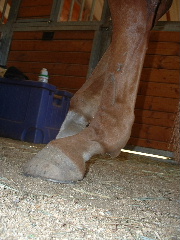 September 19 shod on the 18th: 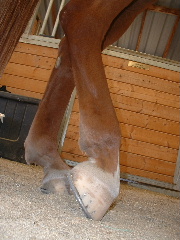 I don't know what to think about today's pictures, I reduced the Smart Tendon supplement a couple of days ago just to see:  fully weighted: 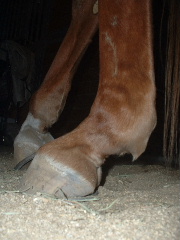 To me he looked better on the 19th than he does today. I'll resume the full dose starting tomorrow and see if that makes a difference. |
| Moderator: DrO |
Posted on Sunday, Sep 27, 2009 - 10:11 am: 1) Proud flesh by definition (granulation tissue poking above the skin) does not form under the skin. But granulation tissue is critical in healing all torn tissues.2) Neither do wounds heal over fly eggs. The decision to use anti-inflammatories is based on whether there is inflammation present. The article Diseases of Horses » Skin Diseases, Wounds, and Swellings » Swellings / Localized Infection / Abscesses » Diagnosing and Assessing Swellings in Horses explains the characteristics of inflammatory swellings. Note that the lack of heat alone does not mean inflammation is not present. Often the best way to deal with many types of swellings of the legs is pressure bandaging, though I do not believe you are supposed to put Surpass under a bandage. You will find several articles on bandaging at Diseases of Horses » First Aid with one dealing with how to bandage different aspects of the horse and the other explaining about using pressure to reduce swelling. DrO |
| Member: sunny66 |
Posted on Sunday, Sep 27, 2009 - 11:16 am: Oh thank you Dr. O, I didn't realize the lack of heat doesn't mean inflammation is not present! Will reread your articles, thank you.I checked him on the lunge, sound at the trot on the straight but a bit uncomfortable. I asked once for a canter just with voice, and he offered soundly, politely and immediately(no hopping behind!), I quickly brought him back to walk. Asked for trot again, just on the straight, much better, so I quit... 8 minutes total so I think I will start back with a lot of walk daily and see what happens. |
| Member: sunny66 |
Posted on Monday, Sep 28, 2009 - 6:32 pm: Dr. O, I just spoke with Brave's breeder. I remembered that she had to put his mom down .... I forgot why so I called her, it was because of DrOpped fetlocks/pasterns. She said the weight of carrying the foal was too much and she DrOpped to the ground overnight.I told her what was going on. She was of course very sad and sorry. I asked about his full sister and she said his sister has never had any of the problems my horse does. Does that mean it may not be genetic? He's doing fine so far. |
| Moderator: DrO |
Posted on Tuesday, Sep 29, 2009 - 10:39 am: No producing a normal foal does not rule out genetics. Many conditions are multifactorial or expressed in the heterozygous state (one normal gene and one abnormal gene) so depend on how the genes line up and who got what gene.DrO |
| Member: sunny66 |
Posted on Tuesday, Sep 29, 2009 - 10:57 am: Ok, thank you Dr. O. As horrible as this is, if true, it would make sense and actually help to know that I'm not a horrible horse owner, that he just has a disease.I will cancel the xrays for now and get ultrasounds to see where we are. Let me know if I should be doing something different. I'm being told to ride my horse at the walk for a short period (20 minutes maximum) since there is no suspension. That he misses having a job with me, and that it would help him lose weight. This comes up when talking with knowledgable horsepeople, and obviously only when sound as he is now. However, my vet does not want me on him until he loses more weight. With this new revelation, I'll be listening to my vet unless you feel it may be ok if he shows no lesions on ultrasounds. |
| Member: scooter |
Posted on Thursday, Oct 1, 2009 - 8:00 pm: Aileen I was browsing around "the horse" (it' been raining all day) and ran across this article, it reminded me of your post.It appears there is a fairly easy test for DSLD now. Dr.O. is this a fairly reliable test? https://www.thehorse.com/ViewArticle.aspx?ID=7219&src=VW |
| Member: kerrief |
Posted on Thursday, Oct 1, 2009 - 11:37 pm: Hi Diane and all,I spoke to mt vet about this (nuchial ligament tissue test); and she said it is not 100%. I was considering it for my horse and decided against it. |
| Moderator: DrO |
Posted on Friday, Oct 2, 2009 - 6:34 am: The problem is that in the origianl Dr Halpers study 5 of the 8 controls had proteogylcan accumulation in the nuchal ligament making the test very non-specific. To read more about this controversy and others click the link in our article on DSLD "The Misdiagnosis....."DrO |
| Member: sunny66 |
Posted on Friday, Oct 2, 2009 - 3:34 pm: Vet called, we talked for quite a while and I'm trying to keep everything straight so if it's unclear, please ask.He said there is no doubt that we would find lesions on ultrasounds, but whether they were from a ligament disease, deteriorating confirmation (straightening hind legs so fetlocks are taking more weight), or from a suspensory injury, we would need ultrasounds to see -- and I think he said we may not be able to differentiate, I really can't remember exactly, Dr. O, would it be possible to differentiate? Went through the block scenario, wouldn't have a good result since he's sound. Asked him about locking him in, versus letting him have pasture, and he said if I am planning to campaign him he would have him locked in stall/paddock. He's not adverse to leaving him out but that was up to me to decide. I told him that he's really happy with a job. He is ok with me riding him for 5 minutes after 15 minutes of handwalking, working up from there if all is good. Trot in a couple of months on long sides only in a couple of months (I'll use the tendon rehab you have Dr. O)... of course that may be mute in a couple of months, but we'll see, if questionable I'm sticking with walking if he holds up. We ended with me calling him if he worsens in any way, xrays and ultrasounds on hold for now. For now I have a sound pony on no meds and I'm very grateful for that. |
| Member: sunny66 |
Posted on Friday, Oct 2, 2009 - 3:53 pm: He also said that increasing circulation would be a good thing, so I'm going to continue using the back on track standing wraps at night. |
| Moderator: DrO |
Posted on Sunday, Oct 4, 2009 - 10:14 am: I agree with your vet I don't think the appearance of the lesions would be diagnostic for the cause Aileen.DrO |
| Member: sunny66 |
Posted on Sunday, Oct 11, 2009 - 10:36 pm: Thank you Dr. O, do you... or anyone... see any improvement? He's in the 1172 area on the weight tape, he started moving around and I got him to 1142... but I don't think that counts... lol.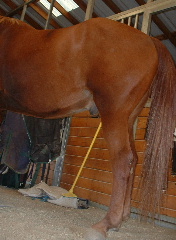 Left hind fully weighted 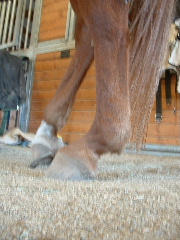 Left hind equal weight 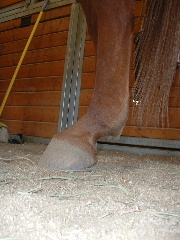 Right hind 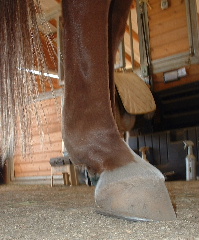 He looks a bit better to me, but I don't know if it's because his winter coat is coming in and just making it look better. Do you on the fully weighted pic, both hooves have a sort of arc on the quarters? Would scooping the quarters help this? So you don't have to scroll up and down, here's the worst one: 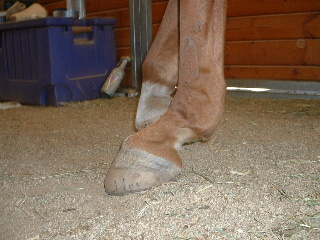
|
| Moderator: DrO |
Posted on Monday, Oct 12, 2009 - 9:12 am: The problem is comparing images is that the position is not fixed Aileen. The amount of weight and flexor contraction change the position so you must evaluate the horse sort of as a average of all the possible conditions. And though you have tried to control for this by fully weighting the legs the angle the foot is on with respect to level with greatly change the pastern position. The photo you ask us to compare to appears to be on more of an angle than the recent ones.DrO |
| Member: sunny66 |
Posted on Monday, Oct 12, 2009 - 7:09 pm: Ok, thanks Dr. O. |
| Member: sunny66 |
Posted on Saturday, Oct 24, 2009 - 11:02 am: There has been improvement in his hoof form. I specifically asked the farrier to take back his heels, evidently she had been hesitant to do so since he was so lacking.For comparison, these pictures are from August - since I don't have pictures just before he was shod in September. August 20 before shod: 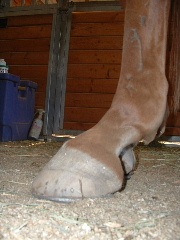 Take note of how long the toe is. August 23 after being shod: 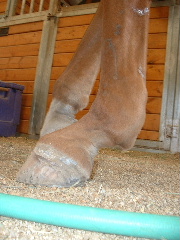 Now, I took pictures yesterday because I was worried I made the wrong decision. I had called the farrier last week and told her I didn't think he was ready to be shod at four weeks. This horse hasn't been able to go longer than 4 weeks for as long as I can remember. He is now at five weeks, she's coming on November 1. Left hind: 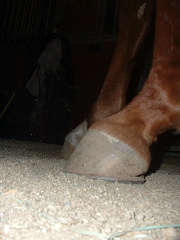 Right hind: 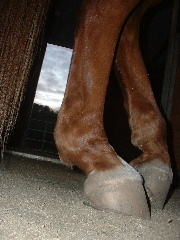 To me, he looks as he does when he was shod on August 23. His toe is no longer growing forward, but up and I think his heels (while still needing work) look healthier. I had added a supplement to his diet the first of October and I think this had a lot to do with this improvement in such a short amount of time. I don't think the trimming change could cause this sort of change in growth in just one appointment, could it? His fetlocks look better, his right pastern seems stronger, but his left hind pastern is more loosy goosy. I had taken him off the Smart Tendon supplement the first of October and he seemed to get worse. While not lame, clearly more uncomfortable. I started him back on it as of last night. We'll see how it goes. Also, I have not been riding him and he's lost another 8 pounds or so. |
| Member: scooter |
Posted on Sunday, Oct 25, 2009 - 7:11 am: Aileen, Braves fetlocks and hooves remind me very much of my old girl Flash. It is so hard to judge if indeed it is completely his fetlocks or the angles of his hooves or both. I know when Flash went through this I was very worried about her.I never did have her shod behind, but the vet and farrier thought eggbars could possibly make her more comfortable. She got to the point we could not trim her anymore, tho I don't think that is related to her fetlocks. Some of your pictures look like her hooves did when I thought her fetlock was going to DrOp to the ground. I wanted to show you this and her hoof from back then (I had a different farrier at that time) This is from summer of 2007, she spent a very uncomfortable winter on these hooves, I had a thread in here about it because I couldn't figure out why she weight shifted so much and was so uncomfortable. I thought she had DSLD. I didn't take very good or very many digital pics then but you will get the idea. 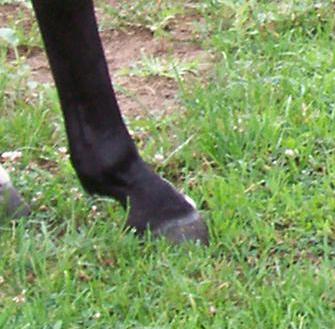 I gave up trying to have her trimmed because it seemed to cause her pain, and let her do her own trimming in back. These are from yesterday, she has not had her back hooves trimmed for over a year. Of COURSE I am not saying Brave shouldn't be trimmed!!! I just want to show you the difference in her hoof angles and how her fetlock looks better, she also is much more comfortable. She also lost about 100#'s which of course helped too. 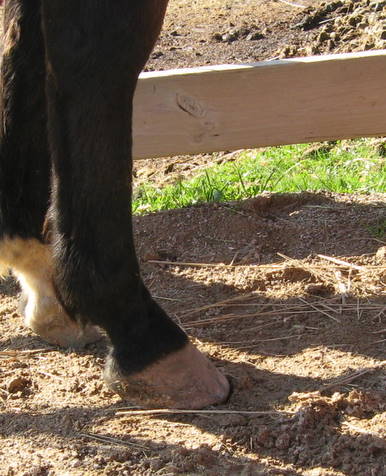
|
| Member: sunny66 |
Posted on Sunday, Oct 25, 2009 - 8:36 am: Oh she looks much better today, Diane!In the first picture I see a lump on the top of the pastern near the hoof, am I seeing it correctly? She also appears to have a bulge on the hoof. Do you think she had negative palmar angles? I'm hoping Brave had NPA. If he did in August, do you see any bulging now? I posted because I was shocked in the change, or lack thereof, from when he was shod. I can't remember the last time he has held hoof form like this, which is why he's on a four week schedule. It'll be six weeks when he's shod next Sunday. I asked the vet about taking his shoes off behind, he said that with the ground soft he would have very little support and it would most likely not be a good idea. Thank you Diane 
|
| Member: scooter |
Posted on Sunday, Oct 25, 2009 - 9:07 am: Aileen I am far from an expert on hooves , hopefully one of the more experienced will chime in if I am way off base. IMHO your picture after shod Aug.23 it appears to me he has quite a steep toe angle in front. It also APPEARS his fetlock looks better before this (aug 23 )shoeing. Personally I think his hoof angles look better in the Aug. 20th pics. There are just so many variables tho so hard to tell. , hopefully one of the more experienced will chime in if I am way off base. IMHO your picture after shod Aug.23 it appears to me he has quite a steep toe angle in front. It also APPEARS his fetlock looks better before this (aug 23 )shoeing. Personally I think his hoof angles look better in the Aug. 20th pics. There are just so many variables tho so hard to tell. Flashes hooves almost started looking like club feet or NPA when that farrier was trimming her, he kept her toe WAY back and did nothing to her heels, her fetlock continued to DrOp and she had swellings was quite a mess! Thankfully she has been able to self trim better than any farrier could trim her back there! |
| Member: sunny66 |
Posted on Sunday, Oct 25, 2009 - 10:49 am: Thanks Diane I'm not necessarily looking at his fetlocks, just the hoof form. You could certainly be correct! I'm not necessarily looking at his fetlocks, just the hoof form. You could certainly be correct! I think he looks better now because his toes/heels are not growing forward (longtoe/underrun heels). His heels appear to be stronger. The lines on his hooves aren't warped as they were in the Aug 20 pic. I can actually see a little bulge in the Aug 20 pic, but can't see one in the Oct pics. I too hope someone chimes in because if something has to change we can do it next weekend 
|
| Member: scooter |
Posted on Sunday, Oct 25, 2009 - 12:58 pm: I think the problem really evaluating his hooves is we are not sure if he has suspensory desmitis or poor hoof angles,which makes it very difficult to comment. In my mares case I have to assume it was her poor hoof angles, she still has weakening suspensories(more from old age than anything) but with the improved angles they are much better.Do you have pictures of his back hooves/fetlocks before you started the different shoeing/trimming? |
| Member: sunny66 |
Posted on Sunday, Oct 25, 2009 - 1:51 pm: Hi Diane, I realize this is difficult, I'm just looking for any ideas and I thank you for your input.Vet said that there would absolutely be lesions on an ultrasound, he had no doubt. Since my horse is technically retired, he didn't recommend spending the $400-$500 for ultrasounds to tell us something he already knew. If I had unlimited funds I would have already had them done, but I'm having to be a bit tight with my money right now. The only difference in the trimming has been to bring the heels back all the way, this was done in September. Previously the farrier had been hesitant to do so due to his pasterns and wanted to keep as much heel as possible. I was watching him walk in the paddock yesterday and was cringing watching him walk away from me. I just videoed him. He is still lax in the pasterns, but he's just barely going below horizontal on some strides, and on others looks actually good for him, not normal by any stretch of the imagination, but good for him. Please excuse my jiggles, whip and lunge line...but this one shows his pasterns clearer than the others. https://s141.photobucket.com/albums/r59/wishes_album/?action=view¤t=DSCF000 2-2.flv Thanks so much for your help 
|
| Member: scooter |
Posted on Sunday, Oct 25, 2009 - 2:56 pm: I understand the tight money thing, my horses cleaned me out pretty good this year!Though until you have a diagnosis you won't know how to treat him. I don't think your vet can be 100% sure he has lesions. I am surprised the US costs so much, of course in this area we don't have digital US. When I had Hanks suspensory US when he had that weird fetlock we could see it good enough with a field US machine...$80  It also showed Flashes lesion when she bowed her tendon. It also showed Flashes lesion when she bowed her tendon. My vet swore up and down Sam had SCC on his penis (from the pictures I saw I would have guessed that too) and was wanting to burn his tumors off him  Turned out it wasn't SCC and poor Sam didn't have to have his tumors burned off! Turned out it wasn't SCC and poor Sam didn't have to have his tumors burned off! I guess my point is until you actually have a diagnosis as Dr.O. says it is all conjecture and you are left guessing, he don't like us doing that I don't think! 
|
| Moderator: DrO |
Posted on Monday, Oct 26, 2009 - 8:09 am: I agree with the veterinarian that degenerative suspensory disease can be made from history and physical exam alone...You seem pleased with the shoeing results...Guys I see you want some input but am uncertain on what?DrO |
| Member: sunny66 |
Posted on Monday, Oct 26, 2009 - 10:31 am: Hi Dr. O, I guess I'm wondering if we're on the right track or way off base with the shoeing. I found this picture on a dsld website.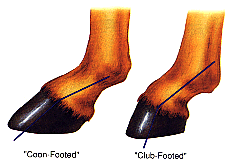 I'm wondering if he was leaning toward the coon foot: 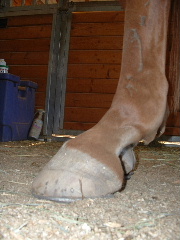 I've shown the pictures I posted a couple of days ago to a couple of barefoot trimmers, and while they said he still needs work, that he does look stronger in the October pics in the hoof capsule. However, I don't know that they have any experience with possible DSLD/ESPA horses and I would like another opinion before Sunday when the farrier comes. Fully realizing that's all it would be, an opinion, because I know it's hard to tell from pics, especially with my bad photography! 
|
| Member: sunny66 |
Posted on Monday, Oct 26, 2009 - 10:35 am: Hi Diane Yes, the ultrasounds would be digital, but it wouldn't be just one ultrasound, it would be all four legs to get a baseline. Which I will do, just can't afford it at the moment. I know you know what it's like to be cleaned out by vet bills! I hope all is well with your herd. Yes, the ultrasounds would be digital, but it wouldn't be just one ultrasound, it would be all four legs to get a baseline. Which I will do, just can't afford it at the moment. I know you know what it's like to be cleaned out by vet bills! I hope all is well with your herd. 
|
| Moderator: DrO |
Posted on Tuesday, Oct 27, 2009 - 4:42 am: Hmmmm, the picture of the coonfooted horse is inaccurate. If you encounter a horse with this hoof conformation there can be two reasons. If the horse has genetically determined low hoof angles (rare) normally he would have a straight hoof pastern axis. If it is do to improper trimming or poor hoof care (common) it causes the pastern angle to rise or become more vertical. Therefore the image with the low hoof angle shows a horse that has both poorly cared for feet and a weak suspensory system.For more on this see the images and descriptions at References » Equine Illustrations » Muscoskeletal Anatomy and Conformation » Foot: Anterior - Posterior balance. DrO |
| Member: sunny66 |
Posted on Sunday, Nov 1, 2009 - 6:07 pm: Thank you Dr. O. He was shod today, no hopping from one foot to the other, taking the shoes off was a fairly non-event. He was still very apprehensive each time the farrier moved, but calmed once she kept his leg in one position. It was still painful for him but he dealt with it with me standing at his head with the line over his back. He was a bit hard on her when she was doing his right hind, I'm not entirely pleased with it, but he was insisting on a lot of rest periods so she hurried to get it done.I think we may be on the right track, but time will tell. Right hind: 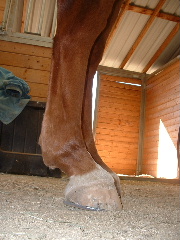 He was much better for the left hind, I am pleased with this: 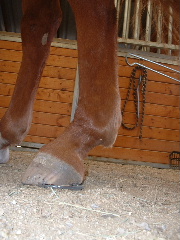 Hind end: 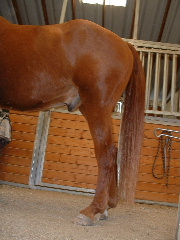 He's at 1156 pounds. You can run your finger along his side and his ribs go... blip blip blip blip - no more searching for ribs!! Woohoo! 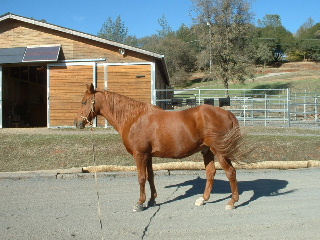 Still a ways to go on the weight but at least some progress is being made. |
| Member: scooter |
Posted on Sunday, Nov 1, 2009 - 7:44 pm: Hi Aileen thanks for the update...his fetlocks look much better in these pictures . His right hoof does leave a little to be desired . His right hoof does leave a little to be desired but as we know the slow but sure method works best! but as we know the slow but sure method works best! Congratulations on the ribs  How is he moving now? How is he moving now?
|
| Member: sunny66 |
Posted on Sunday, Nov 1, 2009 - 9:54 pm: Thanks Diane he's on bute, so I'll know in a couple of days. He's moving pretty much the same as last week. I asked him to trot a couple of steps on Friday to make certain he wasn't lame and he was sound, head at the wither. Today, on bute, he was giving me "tude" with a very pretty trot as I brought a snack out to his pasture. he's on bute, so I'll know in a couple of days. He's moving pretty much the same as last week. I asked him to trot a couple of steps on Friday to make certain he wasn't lame and he was sound, head at the wither. Today, on bute, he was giving me "tude" with a very pretty trot as I brought a snack out to his pasture. I may bute him tomorrow night, we'll see how he feels. I did a lot of accupressure on him today and put the back on track standing wraps on tonight, so hopefully I won't have to bute him tomorrow. Have a good night! |
| Member: scooter |
Posted on Monday, Nov 2, 2009 - 6:01 am: Aileen why doesn't he like his RH done? Is it because he doesn't want to weight the LH, that one had the laminitis right? OR does he not like to bend his RH? Sometimes it is hard to tell. |
| Member: sunny66 |
Posted on Monday, Nov 2, 2009 - 10:36 am: I don't know Diane, that's something the ultrasounds could tell me. I'm just glad that he's improved in the farrier department. We didn't want to push him, it was his idea (waited on him to lift the leg, etc.), but when he said enough, we listened.Farrier thinks shoeing hurt him so bad that's all he remembers. Once he realizes it doesn't hurt that bad any more he calms down. She has a point, but I don't think so, something else is going on. It's possible that since he didn't have a shoe on the left hind when she was doing the right, that it caused discomfort, may have had something to do with it. I'll remind her to do one hoof at a time and see if that improves. No bute since yesterday morning, walking really quite well this morning. Took off the standing wraps and put on clay poultices on both hinds. |
| Member: sunny66 |
Posted on Tuesday, Nov 3, 2009 - 10:05 am: Remind me next time he's shod to try ice after. Wraps and poultice did not seem to help. I took the standing wraps off and he looks more DrOpped this morning. No poultice today.Moving well, bright and alert and silly, just seems more DrOpped. |
| Member: scooter |
Posted on Tuesday, Nov 3, 2009 - 2:57 pm: Aileen when I was worried about my mares fetlocks...they looked worse then Braves I researched a little bit...well a lot! If I recall, wrapping isn't always the best thing to do. I researched a little bit...well a lot! If I recall, wrapping isn't always the best thing to do.
|
| Member: sunny66 |
Posted on Wednesday, Nov 4, 2009 - 10:35 am: oops... the dsld site recommended wrapping I thought... and the poultice. I left him naked last night and this morning, we'll see what I have when I get home.Thanks Diane 
|
| Member: scooter |
Posted on Wednesday, Nov 4, 2009 - 4:13 pm: Aileen at least you will know which way works better, let us know. From what I researched sometimes it helps, and sometimes it doesn't so you have to play with it. I didn't wrap the mare, I did try SMB's on her when her back fetlocks were DrOpping to the ground and they didn't seem to help her at all. They are all different tho.Good Luck |
| Member: sunny66 |
Posted on Monday, Nov 16, 2009 - 6:52 pm: Hi All, Vet came out today, clinic has a half off xrays special this month so I took advantage. My horse would NOT put his hoof on the board to get the hoof laterals. Bouncing all over and freaked out.So we went to the fetlocks. Could not see the tip of the coffin, however, what we could see of the coffin/pastern/fetlock, it looked like he was in alignment, so that's good. He has changes near the sesamoid (sp?) and back of the pastern I think. He is worse on the left than the right. Dr. O, could the changes noted on the xrays cause huge pain responses (jumping all over) and his pasterns to look DrOpped? Then he watched him move sound at walk trot and canter on no pain meds... WHY does he have to be sound when the vet comes? ... sorry that sounds bad but really! So then I asked him if he could watch me ride really quick, I could tack up as he was doing another horse. He did so, then suggested that I sit up and get him off his forehand. The only way I know to do that is to collect him. I did so and vet said he's fine for me to ride on his good days at the walk only for 20 minutes. He has a very long stride, so I have to wonder if collecting him doesn't enable him to reach as much and take as much weight on the pastern, therefore the pasterns don't DrOp as much? Is this viable? Vet thinks the problems could be stemming from his conformation (straightening hind end) changing with age. Vet didn't have a ton of time as he had to get the machine back to the clinic so we didn't chat a lot. We did try for the hoof laterals again before he put the machine away but it was not to be done without tranqs and I really wanted him to see him move. In hindsight, I should have had the vet watch him move first then we could have tranqed him, my big mistake! Vet could feel ribs and we only have 30 more pounds to go! 
|
| Moderator: DrO |
Posted on Tuesday, Nov 17, 2009 - 7:57 am: Hello Aileen, if you will have the veterinarian write a description of the changes he sees and transcribe them here I would be glad to comment. DrO |
| Member: sunny66 |
Posted on Tuesday, Nov 17, 2009 - 10:29 am: Will do Dr. O.I forgot to mention that he did palpate thoroughly his hind tendons. He felt the suspensories were fine, if a bit hard, but he mentioned the flexor tendons could be an issue. Are the flexors the ones that wrap around the fetlock/pastern area? I need to go look at your illustrations. He said the fetlock is hard, maybe some fluid. ps...After watching him go sound, he looked at me and said "he is moving surprisingly well, he is very stoic" ... edited to add that I looked at your illustrations and I think it's the superficial flexor. |
| Member: sunny66 |
Posted on Wednesday, Nov 18, 2009 - 2:50 pm: No report yet, but I did get the xrays of the fetlocks:Left: 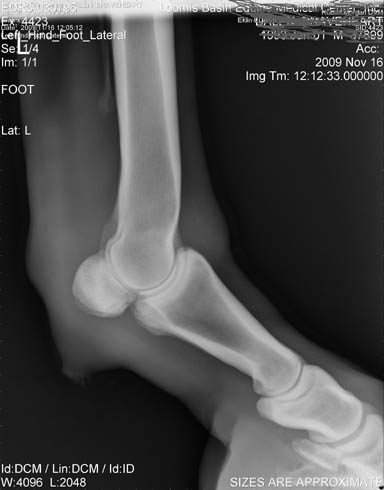 Right: 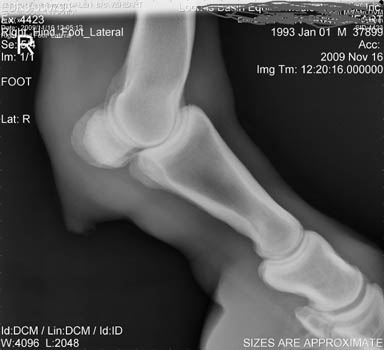
|
| Member: sunny66 |
Posted on Wednesday, Nov 18, 2009 - 10:03 pm: I don't have a report, but he called tonight.He thinks he thought too much of the xrays in the field, not as bad viewing them in the clinic, not bad at all. However, with the sesamoid DrOpping it's causing strain on the suspensories, he said superficial and deep tendons were ok (so I was wayyyy off on that!). He talked with his surgeon and said they could do surgery to fuse him more upright but it's $10 K per leg. Nothing else to do except oral supplements to help his joints. He said he isn't uncomfortable judging from his movement the other day. Take the good and help the bad days. He said he knows I like to be proactive, I could try msm and a tendon supplement (I told him he's already on one with msm) but there are no studies showing improvement. Ok, that's it in a nutshell. I'll take pictures tomorrow. He actually looks quite good behind tonight. |
| Moderator: DrO |
Posted on Thursday, Nov 19, 2009 - 7:25 am: Just one correction to the way you have stated cause and effect in your previous post: it is NOT that "the sesamoids have DrOpped and therefore straining the suspensories". It IS that the degenerative disease of the suspensory that has resulted in stretching of the proximal portion, resulting in the sesamoids being lower and the fetlock DrOpping.DrO |
| Member: sunny66 |
Posted on Thursday, Nov 19, 2009 - 7:25 pm: Thank you Dr. O, I was probably mentally blocking that out.I read your article and it (and the vet) stated that the trimming is of the utmost importance. My concern is the pain he is in when taking off the shoes. I asked if it is a necessary evil. He's been sore - and very lax in the pasterns - for 4-5 days after being shod regardless of how much foot she leaves. He left it up to my farrier (she did say he had a good heel purchase last appointment) as long as he has a good length of, and upright, heel - no underrun heels or no barefoot. He's totally fine with her nailing on the shoes. I don't think I'll be asking her opinion until at least 12 more weeks to ensure his heel purchase stays improved or gets even better first. But if we were to try it, and it didn't work, how much irreparable damage could it cause if he were barefoot just for a week? I'm just asking for an opinion, I realize it's impossible to say for certain without seeing him. Have you dealt with this successfully barefoot? No pictures today, no batteries. But he doesn't look as good as he did yesterday. We had a good long "talk" and he "said" it'll be ok as he kissed away my tears. He's an amazing animal, life isn't fair is it? I really dislike not knowing if my decisions are going to be right. |
| Moderator: DrO |
Posted on Friday, Nov 20, 2009 - 6:50 am: Aileen, if you are asking about DSLD I can say I never had shoes help in any significant way and would consider their use only if I needed to protect the sole, wall horn or build up the foot with artificial wall to balance it.DrO |
| Member: sunny66 |
Posted on Friday, Nov 20, 2009 - 10:03 am: Oh! Well then I'll ask the farrier today what she thinks! Thank you very much Dr. O! |
| Member: sunny66 |
Posted on Sunday, Jan 10, 2010 - 12:09 pm: Hi Dr. O and all,We went barefoot behind. I'll post pictures from Dec 7 and from Jan 2. His heels were severely underrun. I guess I have to get nitpicky again... We had quite a bit of snow and ice then, once that went away his frogs looked normal again. Dec 7 Left Hind 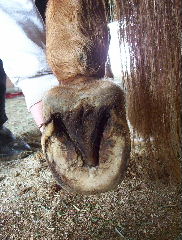  Dec 7 Right hind 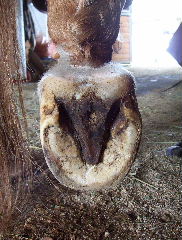 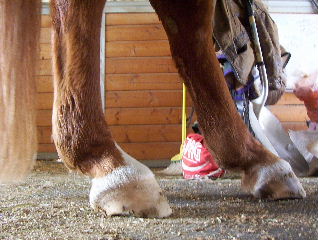 After about 3 weeks he was completely sound, cantering in pasture not spooked, but balanced, happy, and comfy. Sound on the lunge at three gaits as well. I was able to ride him at a walk. While far from perfect, I feel his heels have come back quite a bit and he's starting to have a stronger heel behind. Jan 2 Left Hind 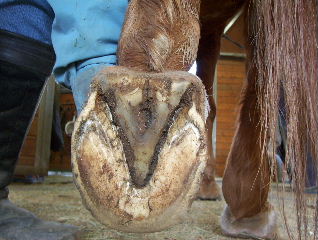 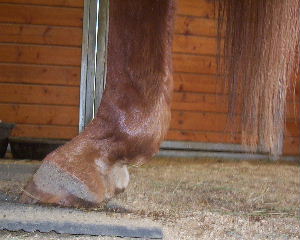 Jan 2 Right Hind 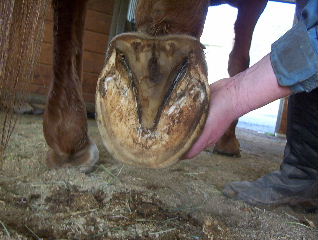  He is now sore again. I have to wonder why he's always sore after the farrier and sound 2 weeks before the farrier comes again. Any ideas? She does take a lot of frog, he was very thrushy on the front feet. Also on the hinds but not as bad. I wonder if as he grows his frogs back he becomes sound. Is this a viable option? I am treating the thrush twice a day. He is in steel shoes on front feet now so I can treat the thrush. Not epona shoes. Xrays on Jan 23 of all four feet. I am increasingly curious if he has something going on in front so he's loading the hinds. He had very flat feet in front and he had veins of thrush all through his sole. However, he's barely growing any foot behind. She had nothing to trim on the 2nd. Just took back his heels, cleaned up his frogs and relieved the quarters. Any input, advice greatly appreciated! |
| Member: vickiann |
Posted on Sunday, Jan 10, 2010 - 5:50 pm: Oh my,Aileen --Those hair lines surely DrOp off at a horrible angle. Don't look good at all. I think the going barefoot is a good idea as in my experience shoes that cover the heels crush the heels. If a horse is sore after a trim I generally feel whatever the farrier did was probably not a good idea or too much at one time. If the horse is sore for an extended time only becoming sound later, that certainly seems even more implied. |
| Member: sunny66 |
Posted on Sunday, Jan 10, 2010 - 6:11 pm: I know they are awful. I have a teeny tiny bit of hope that if we can fix this he may stabilize, at least not get worse. they are awful. I have a teeny tiny bit of hope that if we can fix this he may stabilize, at least not get worse. I agree with you Vicki in that whatever she did was not good, she barely takes off anything. Just the frog, brings back the heels and does the quarters. Even on the front feet she didn't take off much foot at all. She wanted him to go to 6 weeks, but I'm concerned about his feet getting too far out of wack. His front feet are growing forward again, not up. So he has underrun heels in front as well. I'm debating taking off the front shoes next appointment, but I'm concerned that with his hind heels so bad it would be a disaster, even with very soft ground. I had asked a few months ago if his heels were crushed and I was told "no" 
|
| Moderator: DrO |
Posted on Monday, Jan 11, 2010 - 5:38 am: Hmmmm, the farrier takes very little hoof but the horse dependably becomes and remains lame for weeks. From a practical standpoint it suggests more frequent trimming removing even less.I would be interested in following a trim to further localize the lameness to the foot and if the foot: exactly which structures are sore. Perhaps the change in angles causes pain in the DrOpped fetlock or holding the leg up aggravates arthritis in the upper joints. DrO |
| Member: scooter |
Posted on Monday, Jan 11, 2010 - 7:48 am: Aileen his hooves are strange looking, but hard to tell because of his DrOpped fetlocks. The Riders Rasp has been a godsend with Hanks hooves, maybe you could do a little rasping on his hooves between farrier visits? It really is dummy proof and very easy to use. I don't think you could take too much off if you wanted to. |
| Member: sunny66 |
Posted on Monday, Jan 11, 2010 - 3:34 pm: Thank you Dr. O, unfortunately the vet will be out on the 23rd, so he'll most likely be sound. He's sound and happy on equioxx.Farrier is stumped. She did say that she thought it was higher up. I thought the problem was the pulling and tweaking of his hind end to take off shoes behind but he's virtually the same as he was when having to take shoes off. Since taking the hind shoes off, the right hind fetlock seems stronger, but not the left. However, neither are going as far down when he's in motion as he was with shoes on. Diane, she did leave me an extra rasp so I can keep the toes back, but I only had to do it once. She was there and said "Don't do it every day!" lol... I will look into the rider's rasp. Thank you 
|
| Member: sunny66 |
Posted on Wednesday, Feb 3, 2010 - 1:33 pm: Dr. O, or anyone, I'm looking for suggestions for Brave's upcoming trim on February 6. I had xrays taken on Jan 23, the pictures accompanying were taken Jan 24. Vet saw no negative palmar angles, nor any rotation.Left hind: 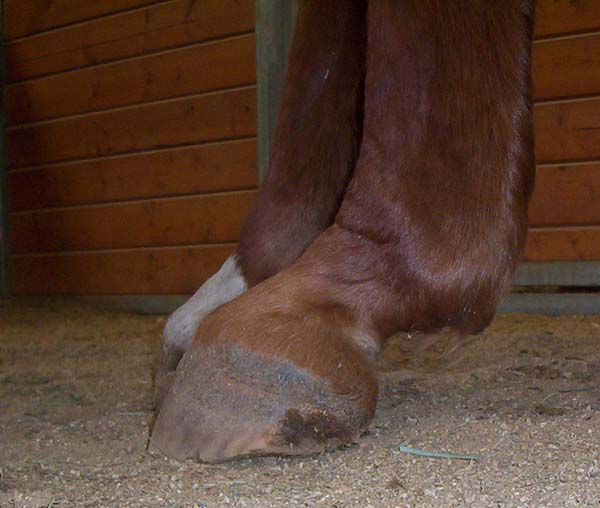 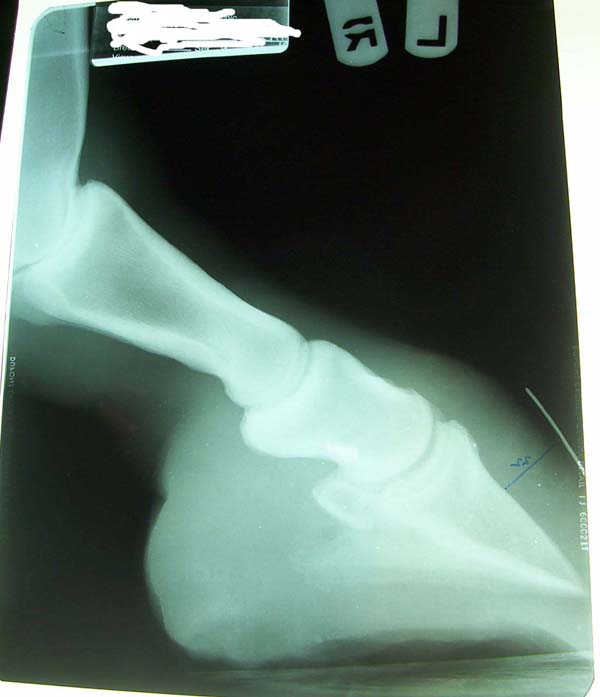 Right hind: 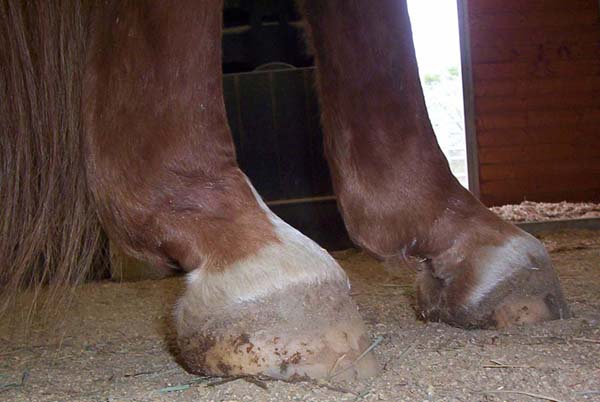 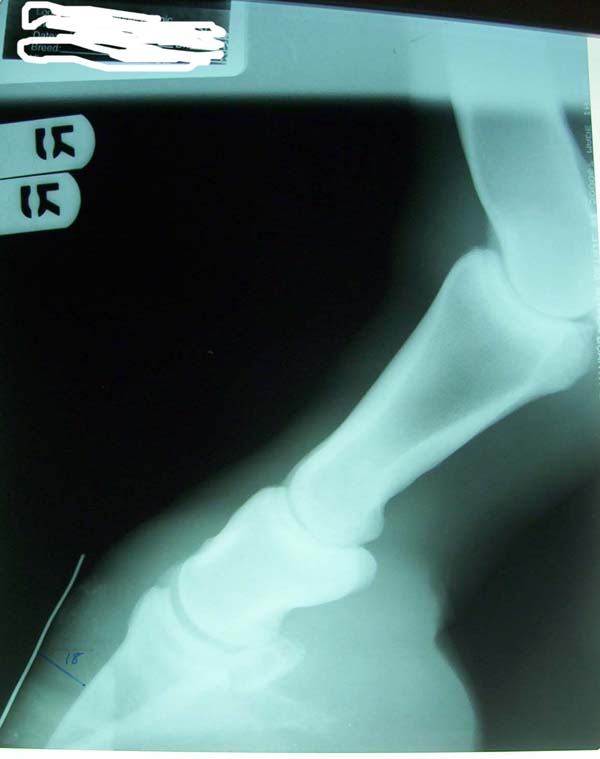 Vet also took xrays of the fetlocks and while they were not worse, they were not better either. If he's on bute he lands heel first, if not on bute he drags his toes and lands toe first. If not on bute he has a very hard time getting up. If on bute he gets up fine but is still dead lame on the right hind for about a minute, then walks fine. Dr. O, What are the chances that he has arthritis farther up maybe in the stifle (I know he has arthritis in both stifles), sac and/or tailbone area that causes him to drag his toes when not on bute? Is all this consistent with dsld/espa? Should I be looking farther up or should I give up? |
| Member: sunny66 |
Posted on Wednesday, Feb 3, 2010 - 1:48 pm: Another question! I am considering taking off his front shoes for a few months(with the vets ok), but I neglected to ask about the fact that he may then load his hind end even more... another but, it is very wet here, the ground is saturated and very soft.Xrays show 13 and 15 mmm sole depth on the front feet - better than the 11 mm in 2008. He lands heel first in front. I would like to get his front feet trimmed more often as he's starting to grow forward in the toes again. Opinions on this? Thanks in advance! |
| Member: scooter |
Posted on Wednesday, Feb 3, 2010 - 6:09 pm: Aileen, I know you are trying very hard to help Brave . I have to say his back hooves look weird... is it because of his fetlocks or is it making the fetlocks worse? I don't know enough about it to say. All I can reiterate are the pics above of my mare and what she looks like now. Different hooves made a tremendous difference on her. Her fetlocks are still DrOpped (not half as bad) and she never needs bute or seems painful. . I have to say his back hooves look weird... is it because of his fetlocks or is it making the fetlocks worse? I don't know enough about it to say. All I can reiterate are the pics above of my mare and what she looks like now. Different hooves made a tremendous difference on her. Her fetlocks are still DrOpped (not half as bad) and she never needs bute or seems painful. I was scrolling thru your thread and his hooves appear to be worse every time you post new pics of them. The way his toe points straight down is strange, it even make me want to work on it! Do the x-rays show the whole hoof including the toe? If they do can you post them? I hope Dr.O. can give you some advice, with the DrOp fetlocks involved I am not sure if the hooves should be like that, or grow like that. What does your vet say about them?  What does your farrier think? |
| Member: sunny66 |
Posted on Wednesday, Feb 3, 2010 - 6:47 pm: Thanks Diane,He actually doesn't look so horrendous - bad but not horrendous - in person. Go figure. In pictures they are awful. His vitals are good, his coat looks great, bright eyed, happy, curious with his great sense of humor, still bounces around sometimes, came in last night at a trot with no headbobbing ... I don't get it. No, I'd have to go the clinic to get more pictures. These aren't digital and I just took pictures with a digital camera  The only thing I can say is that he hasn't been trimmed in 8 weeks, just taken the heels back - which he needs again. He's dragging his toes so I'm assuming that's why his toes are so steep??? There's nothing to rasp back, I haven't touched him. He does have better heel on the right - and inside only on the left hind, but that's the extent of improvement. Vet had me put him on a biotin supplement, said I wasn't giving enough of the biotin, lysine, and methionine (sp?) so he's just started that. Farrier hasn't seen them yet. She's coming on Saturday. I'm hoping to have some sort of idea of what I want by then. Thanks Diane. |
| Member: scooter |
Posted on Wednesday, Feb 3, 2010 - 7:08 pm: Aileen I would think a balanced trim is all you can strive for...looking at theses pictures anyway I would want to shorten his toe wall? Can you get a pic of the bottom of his hoof? I have hardly any idea what I'm talking about, but I drew a line where it looks like he needs evening up quite a bit. This thread takes awhile to load maybe if you started another some one that knows WAY more than me might comment. That toe just jumps right out tho.
|
| Moderator: DrO |
Posted on Thursday, Feb 4, 2010 - 8:17 am: Aileen, I would recommend you continue to follow the trimming recommendations we have in our article, which have not changed since you quoted them above. If we could see the toes in the radiograph we might be able to make some specific suggestions.As to why your horse moves better with bute I can only guess, but it may well be the DSLD is painful and the bute makes this more comfortable. DrO |
| Member: sunny66 |
Posted on Thursday, Feb 4, 2010 - 10:38 am: Thank you Dr. O and Diane,I'm hoping he has enough hoof for the farrier to give him an honest balanced trim this time and that he'll actually stand for it and not give her a bad time. His heels need to come back for certain. Dr. O, The bute continues to wreak havoc on his system, equioxx is better but it doesn't give him as much relief. I am considering trying adequan aggressively, (1 shot a day for 4 days, etc); in the hopes it may help, my reasoning is that his right hind pastern/fetlock is stronger than his left; but it's his right hind that he can't move or bend right after getting up, even if laying on his left side. Thank you both. |
| Member: vickiann |
Posted on Thursday, Feb 4, 2010 - 6:36 pm: Aileen,One thing I learned with my old paint horse, Buddy was that if he didn't want to stand nicely for a farrier it was because the farrier kept doing stuff that caused him pain. I have to think that your horse's feet are out of balance. The hair lines look pretty peculiar. |
| Member: sunny66 |
Posted on Thursday, Feb 4, 2010 - 7:08 pm: Thank you Vicki, I agree, but what is it she's doing?? That's what we can't seem to figure out. I can only guess it's because he won't let her give a proper trim. She has done hardly anything to him in 8 weeks. There is no doubt they are out of balance.In his defense, he started having problems in May when the pads were put on (in the first pictures posted). I was not there for this appointment, the clinic's farrier actually put the shoes on while she watched. This was when she told me he could barely handle getting his shoes off/on. Luckily she loves him and knows that in his heart he's a very good boy; but thinks he's remembering the pain from May. I wonder about that. Is that viable? He's getting banamine (1000 pounds) 2-3 hours before and again (500 pounds) 12 hours later this time to see if that helps at all. Farrier just called to change it to Sunday morning since her Saturday got busy, she doesn't want to be in a rush. She is the best. She's totally open to suggestions and that is hard to find nowadays. |
| Member: rtrotter |
Posted on Thursday, Feb 4, 2010 - 7:51 pm: Aileen,I can personally attest to the fact that horses have very long memories when it comes to things they think are bad. My race mare must have had someone treat her really bad before I got her because she almost flat out refused to get hind shoes on for a very long time ( We got them on but it was a struggle). This was a mare that was handled every day, was fine to pick up,pick out and pack her feet. we tried to desensitize her to the hammering of the nails by tapping her feet with a body brush. Really the only issue she had was with the nailing on of the shoes. I used to dread having the farrier out to do her, she was so bad. She is also the type of mare that does not like having anyone fuss over her. She wants you to do what you need to do and then go away and leave her alone and don't upset her applecart. Anyway, I moved barns and needed to use someone else to shoe her. The new guy got along with her great, but I also noticed that when he went to nail on the shoes, he put the first two nails in to set the shoe( one on each side) and only tapped the nails in lightly instead of pounding them in, then he was able to do the rest of the nails and not upset her. She hardly even moved a muscle. He got the shoes on so fast she didn't even know she was done. I was so used to having a battle, I was really glad to see that it might have been the previous farriers and not the horse. I think she was really glad when I pulled the shoes and went barefoot, she's fine to trim. Rachelle |
| Member: vickiann |
Posted on Friday, Feb 5, 2010 - 4:56 pm: As Rachelle said, horses remember things for a long, long time.This has been proven now by some pretty credible studies, hasn't it? Aileen, maybe this horse really needed more time to pass between having much done. It is discouraging to think that a horse needs to be given pain killers to tolerate farrier care, and this brings back memories to me of giving my paint horse some Bute prior to farrier work, and LOTS of Bute, following work. Though enough weeks had passed that my horse was due for a trim, upon his first look at my boy, his current farrier said that many more weeks needed to pass with the horse being turned out barefoot with nothing being done until there was enough foot to do anything with. After the very first trim my horse was visibly relieved, felt better and seemed grateful. It was as though he was trying to thank me for finally getting it right. He positively loves this farrier who he has had for a few years now, after having been a very difficult case for many, many years for a number of different farriers. I wish that I had taken before and after photos of his feet, and also of the various farriers handling and trimming him. Not to mention videos of the totally different way that he moves now in his old age. No one would have believed it. I still can't believe it, and am so thankful that we finally got it right after many years of constant pain and suffering. |
| Member: sunny66 |
Posted on Monday, Feb 8, 2010 - 3:41 pm: Thank you both, farrier came on Sunday and she saw him get up from laying down. Then saw him attempt to walk off while being deadlame then walking out of it. She was even more certain it was not the feet but higher up.I brought him out and she went to his hind end first. He at first hiked the leg and he started bouncing about and panicked, even with 1000 of banamine in him he gave the same reaction we've been getting. When he realized she wasn't going to hike the leg he let her work on him with no hiking and he was just fine. She was not able to trim a lot, but what she did do looks better than before. I'll try to post pics tomorrow. Dr. O, is there any research on sciatic nerve anywhere? I did a search but not much came up, maybe I'm spelling it wrong. |
| Moderator: DrO |
Posted on Monday, Feb 8, 2010 - 6:18 pm: What would you like to know about the sciatic nerve Aileen?DrO |
| Member: sunny66 |
Posted on Monday, Feb 8, 2010 - 6:48 pm: Anything you can tell me. Is it similar to the sciatic nerve in humans? Would a pinched nerve be a reason for him not able to walk off after laying down or for it to be painful when raising one hip?I realize the dsld could be the cause, but I really do think he's got something else going on farther up as well. Thanks Dr. O 
|
| Member: scooter |
Posted on Tuesday, Feb 9, 2010 - 7:19 am: Aileen, I don't know if you read about Flash and not being able to trim her back hooves. She does the same things as Brave. I suspected her stifle or fetlocks but I'm not sure of the reason for sure. When this first started happening holding her hoof very low worked fine, a long with a gram of bute a few hrs. before trimming for a few years. She did progress thru the years where we can not trim her back hooves and we just gave up. She seems to maintain herself pretty well, they do get long occasionally before they break off and look pretty good.When she gets up from laying down she does the same thing as Brave then walks out of it. Overall she is very comfortable it seems. Her walk and trot look pretty good for an old girl, she does look kind of "tight" when cantering and will bunny hop when breaking into one. |
| Moderator: DrO |
Posted on Tuesday, Feb 9, 2010 - 7:43 am: Yes the sciatic (also known as the ischiatic) nerve in horses has similar origins from the spinal cord and similar anatomical locations as it travels to the target muscle bellies in ths human. Currently diseases of the sciatic nerve in the horse usually revolve around severe injury to the upper leg like fracture of the femur and subsequent damage to the nerve or to inflammatory/degenerative disorders to the distal branches as would be seen in stringhalt.Sciatic nerve root pain from inpingement of the nerve roots, what is termed sciatica in humans, is not well defined in horses. DrO |
| Member: sunny66 |
Posted on Tuesday, Feb 9, 2010 - 10:33 am: Thank you Dr. O,I'm going to have his bodyworker see what he can find. Here are some pics: Left Hind: 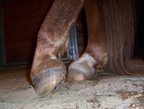 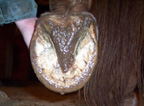  Right hind: 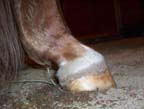 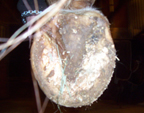 We still have quite a few issues, but overall, I think they have improved, especially those heels. Picking his feet last night he was hesitant to lift the fronts, so I am assuming the hinds hurt. However, he readily follows me around looking for cookies. Will give him equioxx tonight. Is giving it 24 hours after banamine ok Dr. O? |
| Member: vickiann |
Posted on Tuesday, Feb 9, 2010 - 3:29 pm: Aileen,I read further up that your horse was weighting 1156 pounds (and this representing a reduction). To me the feet look small for a horse of that weight and size and I must wonder whether farrier work over the years has gradually reduced the foot size. That had happened to my big paint horse and he had to regrow a lot more hoof, including width, before he became sound. Good luck getting those feet straightened out. It just doesn't look as though there is enough foot there to accomplish much at this point. |
| Member: sunny66 |
Posted on Tuesday, Feb 9, 2010 - 4:02 pm: Thank you Vicki, I agree, it will be a while. But at least his heels are not folding under and they are more stable.His feet are a size 2. He's 15.3. |
| Member: scooter |
Posted on Wednesday, Feb 10, 2010 - 7:44 am: Dr.O. is Braves hoof shape "normal" for a horse with DSLD? IOW Does the hoof angle tend to get steep with DrOpped fetlocks? |
| Member: sunny66 |
Posted on Wednesday, Feb 10, 2010 - 10:47 am: I'd be interested in what Dr. O has to say about that as well Diane. I will say that he does drag his toes and the farrier believes that is why his toe is so steep... self trimming so to speak. I will also say that he stands on his toes, I think it's because it hurts him to weight the heels, but I do not believe that it stems from the feet - I truly believe it's farther up, whether it's the tendons, ligaments, nerves, or a combination of all, I do not know.I believe this since his way of standing has not changed regardless of what we do with the feet. (pads/trailers/no trailers and no pads or bare) He gets significantly worse when taken off the SmartTendon. It has msm in it, I had taken him off the SmartTendon and given him msm instead to see if it was just the msm helping him, he got worse. Put him back on and he got better - not good, but better. If you look at just the sole of his hooves from when we first took off the shoes in December and the ones from yesterday, and not the side view, what would you think? |
| Member: scooter |
Posted on Wednesday, Feb 10, 2010 - 11:46 am: Aileen the pictures are kind of small so it is really hard to tell much about either of the sole views... in both sets it appears his WL is quite stretched...but really hard to tell.I think his "angle" looks better in the Dec. pics. Something just looks quite off in his hooves. That's why I wondered if it was "normal" When Flashes hooves looked like that her fetlocks looked like they could DrOp to the ground at any moment. I thought she had DSLD or something (and she may). It WAS the way the farrier was trimming her that made her hooves look like that and her fetlocks DrOp even more. I kept thinking her hooves looked like that because of her fetlocks... it wasn't in HER case. She does have DrOpped fetlocks, but with the improved hoof angle they aren't half as scary looking and she is much more comfortable. IMHO as I said above his angles seem to look worse everytime you post a pic of his hooves. Would common sense say his fetlocks couldn't change his hoof that fast??? I don't know. Aileen I think you have seen MANY of us go through farriers/trimmers making our horses sore (me included) and you look at their hooves and wonder what is going on. All my farriers seemed to know what they were doing, and I certainly didn't know better (JULIE where are you) IN YOUR case I can't say it isn't his fetlocks doing this and I can't say it is....it does make one wonder tho if it is the chicken or the egg. I feel bad for you trying so hard to help Brave. I know the helpless feeling. I only know enough about hooves to be dangerous, so I hesitate to give any advice, I do know enough to say something about them just doesn't look right. Left Hind early Jan...which I think looks better, but take that FWIW 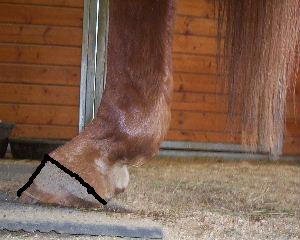 Recent left hind... about 8 weeks later? His hoof looks jammed according to the hairline. His fetlock looked better in the Dec/Jan. pics..IMHO 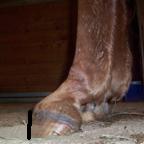
|
| Member: sunny66 |
Posted on Wednesday, Feb 10, 2010 - 12:33 pm: Oh yes, see, he's standing on the mat in the pic you like. In the pic you don't like he's able to dig his toes in.. I can't keep him on that mat unless someone else holds him while I take pictures. He just backs up off it. At first I was convinced that it HAD to be his feet causing that reaction, but I am now not certain of that at all.He's worse without his tendon supplement, I even took him off it and just added msm to his diet thinking that's what was helping him, but he got worse. But when I added the tendon supp back, he got better. I understand your critiques about my farrier. But I want to defend her a bit. First, she's the first farrier who will actually listen to suggestions and - with his hoof in hand- use her judgment as to whether it would be wise to try it. Quite a difference from the farriers before her who would take a vet's prescription, apply it ONE time, then take it upon themselves to cease and do it their way. One last thing about my farrier, the vets love her because she fixes horses. She's not infallible and sometimes makes mistakes, but for the most part she is really good. So, give me suggestions, she will listen if it applies to my horse or will do it if my vet says so. Here are the soles: Dec 7 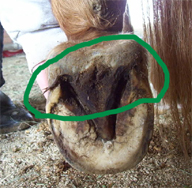 Feb 8 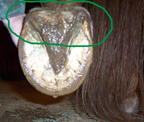 I outlined in green where I feel his improvement is. |
| Member: scooter |
Posted on Wednesday, Feb 10, 2010 - 1:35 pm: Aileen I wish I could make suggestions, as I said I know enough to be dangerous and that's about it Hopefully Dr.O. will have an opinion or the more experienced hoof people. Hopefully Dr.O. will have an opinion or the more experienced hoof people. Even if his toe is buried in the last pic his hair line still looks jammed and wavy. Dunno. Hope you can find an ans. |
| Member: sunny66 |
Posted on Wednesday, Feb 10, 2010 - 2:02 pm: Diane, you're selling yourself short Are you talking about the quarters? Yes, they are jammed - like his toes are being drawn back toward the heel, right? I was told it would not fix itself right away, it would take time - it's been 2 months. If that is not the case, please let me know. I feel that the fixing of those folded over heels and bringing them back - I think it's at least a full inch they've come back - is a great first step in fixing his feet. Please tell me if I am wrong. |
| Member: vickiann |
Posted on Wednesday, Feb 10, 2010 - 2:31 pm: My old boy has always done poorly when off of his Cora-Flx, Aileen, and he is still on it, but in his case the real problem was all of the "correcting" that farriers and Vets had done for him over the years.He had to grow a normal foot back to finally achieve soundness. Good luck with further future improvements. I hope that you find some answers. |
| Member: sunny66 |
Posted on Wednesday, Feb 10, 2010 - 3:00 pm: You don't believe that the current sole pic looks normal? Could you please show me what one looks like, I'm starting to panic here. She has barely done anything to his feet in the last 2 months.The fetlock problem is not going away.ever. I realize that. I am looking strictly at the feet. Thanks for your input, Vicki and Diane. |
| Member: vickiann |
Posted on Wednesday, Feb 10, 2010 - 6:39 pm: Well, I agree with Diane that the hair lines look bad.It is a little hard to tell about the heels in the photos. For a relatively large quarter horse type, I would like to see a rounder, broader looking hoof shape for back feet than what is shown. I'm no expert at all but I know that my paint horse's back feet had to change size and shape for improvement. |
| Member: scooter |
Posted on Thursday, Feb 11, 2010 - 7:36 am: Aileen his fetlocks do need to be taken into consideration when looking at the hooves. That's why I have no idea, I can only say what happened with my mare when her hooves looked like that and as we know they are all different I am very curious what Dr.O. thinks tho. |
| Moderator: DrO |
Posted on Thursday, Feb 11, 2010 - 9:06 am: I am having trouble evaluating the foot conformation because the soft footing may effect hoof position and difficulty evaluating if the horizontal aspect of the image is parallel with the ground. However horses with significant toe drag do develop a more up right hoof conformation as they wear away the toe.DrO |
| Member: ajudson1 |
Posted on Thursday, Feb 11, 2010 - 9:09 am: I've been following this guys, and have no clue what is the best route to follow. I got nothing to offer, except those angles scare me! Funny, hoof look better from the bottom, but from the side looks so snubbed at the toe, and the angle all wrong. In fact the angle isn't as bad as that snubbed to look going back to the last pictures.Best of luck, I hope you start seeing some more positive changes soon. |
| Member: sunny66 |
Posted on Thursday, Feb 11, 2010 - 10:57 am: Thanks all,Angie, I'm so glad you said his sole looks better, I was really starting to question myself. I realize the angles are not good, but I just don't know if we can fix that. I am hoping he is out in his spine and it's pinching a nerve but I realize it's a reach to hope for that. I will say that with him on the mat he looks virtually identical in the picture of him on the mat above. Maybe these will help with the heels. The blue line indicates where the heels are in each pic: Dec 7 - just after taking the shoes off: 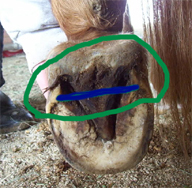 Feb 8: 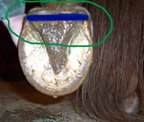
|
| Member: stek |
Posted on Thursday, Feb 11, 2010 - 11:21 am: Aileen I definitely see an improvement in the sole pics, his heels look like they were pretty underrun and are coming back under him now. That can be a very difficult process, especially considering the other things you are dealing with. It is hard to evaluate his angles since he was on soft ground in the first set of pics, but not much you can do about that now =)Maybe some complete conformation shots would help if you can get them? |
| Member: sunny66 |
Posted on Thursday, Feb 11, 2010 - 12:12 pm: Oh thank you Shannon I will take more pictures on Saturday. When you say complete conformation shots, I'm guessing you want the following: I will take more pictures on Saturday. When you say complete conformation shots, I'm guessing you want the following: From the side at each shoulder From the front From the rear Are there others you - any of you - would like? Aside from his feet on mats? |
| Member: stek |
Posted on Thursday, Feb 11, 2010 - 7:20 pm: Yes the angles you describe will help tell how he's standing overall.I would be curious to see a whole body shot too as well as his fetlocks with him standing on hard ground and weighting all four equally (if you can get one!). I agree that his fetlocks look significantly better in the Dec/Jan pics than the others, and I'm wondering if it's just the way he's standing or what? Maybe my eyes are playing tricks on me? |
is The Horseman's Advisor
Helping Thousands of Equestrians, Farriers, and Veterinarians Every Day
All rights reserved, © 1997 -
